2. 中山大学地球科学与地质工程学院, 广州 510275;
3. 中国科学院大学, 北京 100049;
4. 湖南省地质矿产勘查开发局402队, 长沙 410004;
5. 中南大学地球科学与信息物理学院, 长沙 410083
2. School of Earth Science and Geological Engineering, Sun Yat-sen University, Guangzhou 510275, China;
3. University of Chinese Academy of Sciences, Beijing 100049, China;
4. Team 402, Hunan Provincial Bureau of Geology and Mineral Exploration and Exploitation, Changsha 410004, China;
5. School of Geosciences and Info-Physics, Central South University, Changsha 410083, China
扬子与华夏地块交接转换地带被称为“江南古陆”(黄汲清,1954),也称江南造山带或江南-雪峰古陆 (李江海和穆剑,1999;Zhao and Cawood, 2012; 王自强等, 2012; Zhang and Zheng, 2013;图 1a)。该区不仅以广泛发育元古代浅变质的火山-碎屑沉积岩而著称,而且也是华南晚中生代以来构造-岩浆作用和金及金多金属成矿作用的重要区域 (许德如等,2009)。随着罗迪尼亚超大陆聚合和裂解相关研究的兴起,前人对江南造山带区域构造演化和地球动力学背景进行了广泛的讨论 (Hsü et al., 1990; John et al., 1990; Gilder et al., 1996; 彭渤和黄瑞华, 1996; Zhou and Li, 2000; Wang et al., 2001, 2005, 2013a, b; Pirajno and Bagas, 2002; 范蔚茗等, 2003; 许德如等,2009;刘恩山等,2010;张国伟等,2011;柏道远等, 2010, 2011, 2012, 2014;Zhang and Zheng, 2013;Zhao,2015)。与之相关的成矿作用研究也引起了地质学家的关注,并划分出与变质沉积作用有关的成矿 (张进等,2010)、与岩浆活动有关的成矿 (杨明桂等,2009;Chen et al., 2014) 及与构造变形相关的成矿 (汪昌亮等,2011;王自强等,2012) 等多种类型。江南造山带中段的湖南境内产有一批多金属矿床,如东有黄金洞、万古、大洞、万源洞、洪源、雁林寺、高田、柏树等金矿床,铜鼓、横洞、井冲、七宝山等铜多金属矿床;西有沃溪、铲子坪、银马洞等多金属矿床 (刘英俊等, 1989; 刘英俊和马东升, 1991; 毛景文和李红艳, 1997; 图 2)。其中湖南东北部 (即湘东北地区) 金及金多金属矿床曾一致被认为与韧性推覆剪切构造及其派生的裂隙系统密切相关 (黄镜友, 1997; 童潜明, 1998; 刘亮明等, 1997, 1999;符巩固, 2001; 符巩固等,2002;肖拥军和陈广浩, 2004, 2007;周永章等, 2012, 2015),但构造与成矿的耦合关系仍未阐明。关于构造的类型、成因、时代、变形次序等仍存在分歧。本文对湘东北地区元古代以来控矿构造的特征和矿田构造的演化进行了研究,主要从区域构造控制的演化和金及金多金属矿床变形的特殊性着手,深入分析江南造山带中段构造演化对矿田构造格局的展布作用;以宏-微观构造、几何学、运动学、动力学及变形时代与构造环境为研究角度,对矿田构造发育和构造组合对金、铜、钴等矿产赋存状况的控制作用进行揭示。为深入理解自元古代以来华南构造演化与成矿的关系,正确理解江南造山带及邻区金及金多金属矿床成矿地球动力学机制提供重要的参考依据。
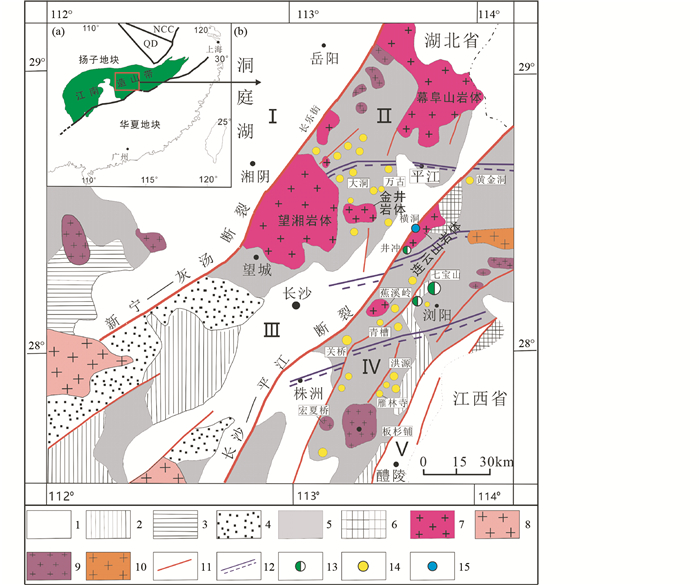
|
图 1 华南构造划分 (a, 据Chen and Jahn, 1998) 及湘东北地区大地构造图 (b, 据许德如等, 2009) 图a中QD-秦岭-大别造山带; NCC-华北克拉通;图b中:1-第四纪-白垩纪; 2-三叠纪-泥盆纪; 3-志留纪-震旦纪; 4-新元古界板溪群; 5-新元古界冷家溪群; 6-古元古界-太古界?7-燕山期花岗岩; 8-印支期花岗岩; 9-加里东期花岗岩; 10-元古宙花岗岩; 11-断裂; 12-韧性剪切带; 13-金矿床 (点); 14-铜多金属矿床 (点); 15-钴矿床 (点); (Ⅰ) 汨罗断陷盆地; (Ⅱ) 幕阜山-望湘断隆; (Ⅲ) 长沙-平江断陷盆地; (Ⅳ) 浏阳-衡东断隆; (Ⅴ) 醴陵-攸县断陷盆地 Fig. 1 Tectonic framework of the South China Block showing the location of the Jiangnan Orogen (a, after Chen and Jane, 1998) and geological sketch map of northeastern Hunan Province showing the tectonic, magmatic and stratigraphical framework as well as the dominant Au-, Cu-and Co (-polymetallic) ore deposits (b, after Xu et al., 2009) In Fig. 1a: QD-Qinling-Dabie orogenic belt; NCC-North China Craton; In Fig. 1b: 1-Quaternary-Cretaceous; 2-Triassic-Devonian; 3-Silurian-Sinian; 4-Neoproterozoic Banxi Group; 5-Neoproterozoic Lengjiaxi Group; 6-Paleoproterozoic-Archean (?) 7-Yanshanian granite; 8-Indosinian granite; 9-Caledonian granite; 10-Proterozoic granite; 11-faults; 12-Ductile shear zone; 13-gold deposits and occurrences; 14-copper polymetalic deposits and occurrences; 15-cobalt deposits and occurrences; (Ⅰ) Miluo basin; (Ⅱ) Mufushan-Wangxiang fault-uplift; (Ⅲ) Changsha-Pinjiang basin; (Ⅳ) Liuyang-Hengdong fault-uplift; (Ⅴ) Liling-Youxuan basin |

|
图 2 江南造山带中段湖南地区主要矿床分布图 (据毛景文,1997) Fig. 2 The distribution map of main ore deposits in the Jiangnan Orogen domain in the Hunan (after Mao, 1997) |
湘东北地区经历了自元古代以来的扬子和华夏地块碰撞、聚合、裂解,早古生代的陆内造山、晚三叠纪的华南陆块和华北陆块最后碰撞,以及中侏罗-白垩时期的古太平洋板块与欧亚大陆斜俯冲的远程效应等多期构造运动事件 (Xu et al., 2007;Hsü et al., 1990;傅昭仁等,1999;饶家荣,1993;王剑,2000)。武陵运动后,湘东北地区隆升为陆,使原本沉积了一套以火山-杂陆屑复理石建造为主的岩系 (何开善,1986),在SN向挤压应力的作用下,产生紧密线性褶皱,并遭受区域变质作用,形成了区域出露最广的褶皱基底-冷家溪群 (湖南省地质调查院,2002①;湖南省地质矿产局, 1988)。加里东期,湘东北响应了华南的构造-岩浆-造山作用,形成了以板杉铺岩体、宏夏桥岩体以及张坊岩体为代表的岩浆活动产物 (王岳军等,2001;赵振华等,1998;郭锋等,1997;Zhou and Li, 2000)。印支运动之后,由于造山作用是从周边向板内延续,故造就了华南内陆地区在早三叠世以前的地层普遍发生褶皱变形并伴随一系列逆冲推覆构造 (Li, 1999; Li et al., 1999; 陈旭和戎嘉余, 1999),同时发生广泛的变质作用和岩浆作用 (Chen and Jahn, 1998; 王岳军等, 2002, 2005;徐夕生,2008;范蔚茗等,2003;邓希光等,2004;杨明桂和王昆,1994;陈培荣等,1999),形成了广泛的陆内隆起和坳陷 (王国平, 1983; 罗志立和刘树根, 2002; 张国伟等, 2013)。此时,位于陆内造山作用边界的湘东北地区,并不是构造的中心,则形成一系列逆冲-推覆构造及以NEE向为轴迹的褶皱 (李三忠等,2011;徐先兵等,2009),在地形上表现为穹隆-盆地构造 (Chu et al., 2012;王建等,2010;汪劲草等,1999;张岳桥等,2009)。晚中生代以来,受到古、今太平洋向东亚大陆俯冲,华北板块和华南板块的相互作用以及华南大陆内不同陆块间的相互作用的远程效应 (周新民,2003),湘东北总体处于SE-NW方向挤压应力场的作用之下,形成总体由一系列NNE向的走滑深大断裂,如汨罗-新宁断裂、长沙-平江断裂、浏阳-醴陵-衡东断裂等组成的构造格局 (王德滋,2004;陈培荣等,2002;Xu et al., 2007)。同时,伴随大规模的花岗岩体 (如连云山、金井和望湘岩体等;湖南省地质矿产局, 1988)。根据地层、构造、岩浆岩等的分布特征,将研究区分割成系列相间的断隆和断陷,自北西向东南分布有汨罗断陷盆地、幕阜山-望湘断隆、长沙-平江断陷盆地、浏阳-衡东断隆、醴陵-攸县断陷盆地。因而,湘东北地区大致展布为由NNE向断裂所控制的、以“两隆三盆”为特色的、雁列式“盆-岭”构造框架 (图 1b)。
①湖南省地质调查院. 2002.长沙市幅H49C004004 1/25万区域地质调查报告
长沙-平江断裂 (简称长平断裂带) 位于湘东北地区连云山断隆带与幕阜山隆起带之间,是湘东北地区一条规模巨大的,长期活动的复合断裂带 (图 1b),也是控制湘东北地区中新代以来红盆的主要边界断裂,是该区晚中生代拉伸构造型式的重要组成部分 (张文山,1991)。该断裂带在属性上为韧性剪切带,是由数条时分时合的压扭性断裂及其间所夹动力变质岩带组成,其NE端延展至赣西北、SW端向桂北伸入,在湖南省境内全长达460km,总体走向NE35°、倾向NW。野外调查表明,自西而东包括F1、F2、F3、F4和F5等五条断裂,呈北北东向大致平行展布 (湖南省地质矿产局,1988;许德如等,2009)。其中F2为长平断裂带主干控矿断裂,总体走向北东30°,倾向北西、倾角40°左右。断裂带内构造挤压破碎岩和构造蚀变角砾岩广泛发育,其中构造挤压破碎带宽约数十米至百余米,岩石挤压片理化、糜棱岩化、碎裂岩化、劈理化以及构造透镜体极为发育 (宾清和龚玉红,2003)。断裂面沿走向及倾向呈舒缓波状,下盘低序次构造发育。断裂带两侧岩性存显著差异,其东南侧为新元古代冷家溪群和晚中生代连云山岩体 (U-Pb年龄145Ma; Deng et al., 2017) 及蕉溪岭岩体 (U-Pb年龄162Ma;湖南省地质矿产局,1988) 组成的变质核杂岩 (张文山,1991);北西侧则为发育有巨厚白垩纪红色沉积岩系盆地及望湘 (U-Pb年龄164Ma;湖南省地质调查院,2002)、幕阜山 (Rb-Sr年龄170Ma;湖南省地质调查院,2002)、金井岩体 (U-Pb年龄164Ma;李鹏春等,2005)。
野外地质考察及结合前人研究,发现长平断裂带具有多期次活动变形的特征,在主活动期,经历了早中侏罗世左行走滑-剪切并具逆冲推覆、侏罗-白垩纪的走滑-拉伸和更新世-第四纪的挤压三个演化阶段 (张文山,1991)。连云山花岗岩形成于第一个演化阶段 (许德如等,2009),该岩体在形态上表现为由20个岩性单元所组成的、不规则的扁圆形状体,片麻状黑云二长花岗岩是其最早形成的岩性,具有走滑-韧性剪切热动力变质重熔的特征,包含有大量的、混合重熔程度不等的冷家溪群地层的残留体。围岩主要为新元古代冷家溪群变质沉积碎屑岩,岩体与围岩接触部位热接触变质强烈,外变质带宽一般200~2000m,最宽处可达20km。在花岗岩中,常见云母、石榴子石、夕线石等变质矿物残余 (图 3a, b),岩体内片麻状岩石与块状岩石在剖面上重复出现,具明显的韵律性,并各呈带状延伸,反映了花岗岩的原地重熔性质 (图 3c;傅昭仁等,1999;李先福等,2001)。此后,又发育源自深部的、具S型花岗岩浆特征的块状中粒斑状黑云二长花岗岩侵入 (图 3d;傅昭仁等,1999)。
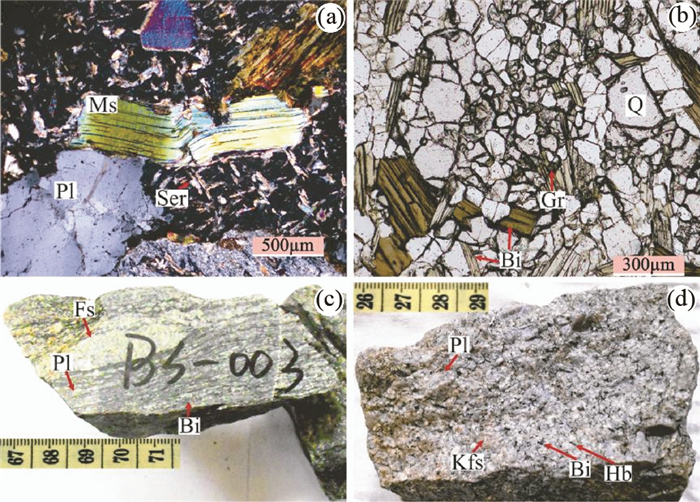
|
图 3 连云山岩体中典型岩石类型和显微照片 正交偏光下 (a) 和单偏光下 (b) 连云山花岗岩显微照片;(c) 片麻状构造花岗岩;(d) 块状中粒斑状黑云二长花岗岩.Ms-白云母; Ser-绢云母; Fs-长石; Kfs-钾长石; Pl-斜长石; Bi-黑云母; Hb-角闪石; Gr-石榴子石 Fig. 3 Representative rock types and photomicrographs of Lianyunshan granites Photomicrographs showing mineral assemblages and textures of Lianyunshan granites under CPL (a) and PPL (b); (c) gneissic granite; (d) medium-grain, porphyritic biotite monzonitic granite with massive texture. Ms-muscovite; Ser-sericite; Fs-feldspar; Kfs-potassium feldspar; Pl-plagioclase; Bi-biotite; Hb-hornblende; Gr-garnet |
由于各个时期区域主应力场的不同,产生了一系列不同方向、性质的构造,而正是这些构造的相互叠加和改造,对区内岩浆岩的产出和矿床的形成起着至关重要的控制作用。湘东北地区主要金矿类型包括剪切带型、斑岩型、基性岩型和浸染型 (刘荫椿,1989;罗献林, 1988, 1990;刘英俊和马东升,1991;Liu et al., 1993;马东升和刘英俊,1991;张乾等,1992;柳德荣等,1994),以剪切带型为最重要,主要分布于长平断裂带两侧的新元古代地层中,与断隆带及隆-坳转换带构造密切相关 (袁兰陵和季玮,2008),代表性矿床有产于幕阜山-望湘断隆带的大洞-万古金矿床 (即大万金矿);产于浏阳-衡东断隆带的黄金洞、雁林寺及大官冲金矿床。铜矿类型可划分为四种,即斑岩型、热液裂隙充填型、沉积型和蚀变基性岩型 (金维群等,2000;刘姤群等,2001),以前两种为主,其中斑岩型铜矿以赋存于浏阳-衡东北 (北) 东向断裂带与宁乡-浏阳东西向构造带复合部位的七宝山铜多金属矿床为代表;而热液裂隙充填型则以产于长平断裂带中段构造蚀变岩带中的井冲铜多金属矿床为代表。相对于金、铜矿床而言,区内钴矿点 (床) 分布较少,主要是以赋存于浅变质碎屑岩中的、与岩浆-热液裂隙充填有关的横洞钴矿为代表。以上这些矿床分布具有一个共同特征,是一般不产出于断隆带的中央部位,而多分布于断隆与断陷盆地转换带的2~5km范围内的断隆斜坡上,且与断陷盆地的大小无关 (符巩固等, 2002);在区域上,金及金多金属矿床和矿化点分布呈“东西成带南北成行”的规律 (图 4)。
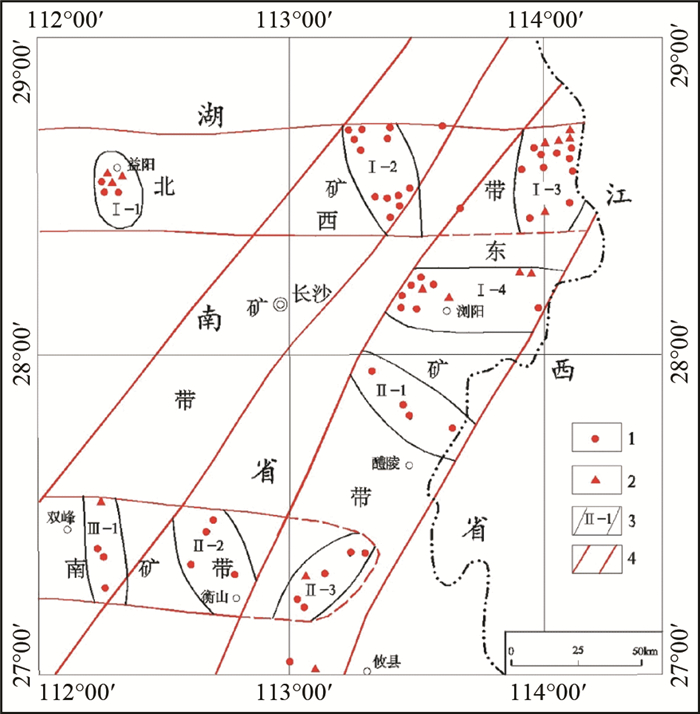
|
图 4 湘东北地区金矿床和 (矿化点) 分布规律图 (据符巩固等, 2002) 1-金矿化点; 2-金矿床; 3-矿床 (矿化点) 密集区; 4-成矿带 Fig. 4 Map showing the disciplinarian distribution of gold ore deposits and mineralizing dots in northeastern Hunan Province, China (after Fu et al., 2002) 1-gold mineralized spots; 2-gold ore deposits; 3-the compact district of gold ore deposits and its mineralized spots; 4-the metallogical belts of gold ore deposits |
黄金洞金矿床位于连云山-衡阳走滑断隆带的NE端、连云山岩体NE面10km处 (图 1b),由金枚、金塘、杨山庄等3个主要矿段组成,涵括杞木造-黄砂港、金枚-大地里、金塘-杨山庄和沈坳里-冷水井四个矿化蚀变带 (图 5),预测资源量可达到大型规模。地层以新元古界冷家溪群粉砂质板岩、砂质板岩为主,岩浆岩在矿区内没有岀露,褶皱、断裂构造都很发育。由于构造的影响,金矿脉顶、底板岩石节理、裂隙发育,以剪节理为主,张节理次之,常成群成组出现,切割岩层呈菱形破碎。
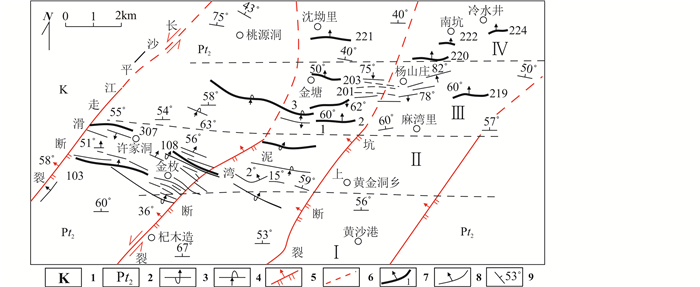
|
图 5 湘东北地区黄金洞金矿地质图 (据罗献林, 1988修改) 1-白垩纪地层; 2-新元古代冷家溪群; 3-倒转背斜; 4-倒转向斜; 5-走滑断裂; 6-推测断裂; 7-矿脉及其编号; 8-岩层产状; 9-地层产状符号.(Ⅰ) 杞木造-黄砂港矿化蚀变带; (Ⅱ) 金枚-大地里矿化蚀变带; (Ⅲ) 金塘-杨山庄矿化蚀变带; (Ⅳ) 沈坳里-冷水井矿化蚀变带 Fig. 5 Map showing the geology in Huangjindong gold deposit, northeastern Hunan Province, China (modified after Luo, 1988) 1-Cretaceous stratum; 2-Neoproterozoic Lengjiaxi Group; 3-overturned anticline; 4-overturned syncline; 5-the strike-slip fault; 6-speculated fracture; 7-the vein and its number; 8-attitude of rock; 9-attitude of stratum. (Ⅰ) the mineralization alteration zone of Jimuzao-Huangshagang; (Ⅱ) the mineralization alteration zone of Jinmei-Dadili; (Ⅲ) the mineralization alteration zone of Jintang-Yangshanzhuang; (Ⅳ) the mineralization alteration zone of Shenaoli-Lengshuijin |
目前有13条矿脉,走向一般近东西向或北西西向,倾向朝北、倾角为40°~75°,沿走向延伸一般约1km、地表可见厚度为0.5~2.1m,但金塘矿区3号矿脉长度最大,达2645m。矿体呈似层状、透镜状及脉状产出。矿石类型以破碎蚀变板岩型及石英脉型为主,在空间上相伴出现 (图 6a, b)。金属矿物以毒砂和黄铁矿为主 (图 6a),还有少量辉锑矿、白钨矿、方铅矿、闪锌矿、黄铜矿、磁黄铁矿及自然金 (图 6d, e);脉石矿物主要为石英、方解石,此外,还有少量的绿泥石、绢云母及碳酸盐 (图 6c)。矿石结构有自形、他形粒状、不等粒镶嵌及碎裂结构。矿石构造有角砾状、块状、条带状、脉状及浸染状构造。金元素主要以不可见金的形式存在于毒砂和黄铁矿之中,可见少量的自然金,富集于断裂挤压破碎带及紧闭褶皱的转折端 (图 6f)。围岩蚀变主要有硅化、褐铁矿化、黄铁矿化、毒砂化、方铅矿化、闪锌矿化,含少量绿泥石化、白云母化,深部还见碳酸盐化,矿化、蚀变具有很强的分带性 (图 5)。蚀变类型与金矿化密切,尤其以褐铁矿化、黄铁矿化和毒砂化最显著,强蚀变地段多为主要矿化地段。
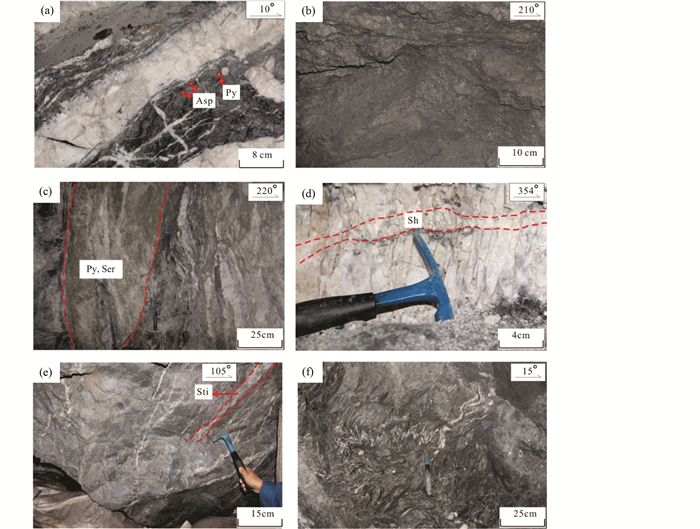
|
图 6 黄金洞金矿主要矿脉以及蚀变的井下照片特征 (a) 石英脉型金矿脉,与石英脉接触的板岩中富含毒砂和黄铁矿等载金矿物; (b) 破碎蚀变板岩型金矿脉,可见较强的毒砂化和黄铁矿化; (c) 含矿石英脉周围的叶蜡石化和绢云母化; (d) 石英脉型金矿脉中包含的细小的白钨矿脉; (e) 破碎蚀变板岩型金矿脉,其中包含一薄层的辉锑矿脉和较多细小的石英脉; (f) 断裂挤压带中细小的石英脉受应力作用形成挠曲.Py-黄铁矿; Asp-毒砂; Sh-白钨矿; Sti-辉锑矿; Ser-绢云母; Pyl-叶腊石 Fig. 6 Photographs showing texture and alteration features of mainly ore-bodies from Huajindong gold deposit (a) quartz vein type gold vein, in contact with the quartz vein of slate is rich in arsenopyrite and pyrite; (b) broken slate alteration type gold lode, showing strong arsenopyrite and pyrite; (c) ore-containing quartz veins shows sericite & pyrophyllite; (d) fine scheelite vein is contained in gold veins; (e) broken slate alteration type gold vein, which contains a thin layer of stibnite veins and more small quartz veins; (f) squeeze a small fracture zone in quartz veins formed by flexural stress. Py-pyrite; Asp-arsenopyrite; Sh-scheelite; Sti-stibnite; Ser-sericite; Pyl-pyrophyllite |
作为黄金洞矿区主要控矿断裂泥湾断裂 (图 7),总体走向大致40°,倾向北西,倾角36°~65°,属于平移逆断层,是含矿热液的主要通道,对褶皱和矿体起到一定破坏作用,但错距不大,两盘岩层和矿体尚能互相对应 (图 7)。在实地野外工作过程中发现,金矿脉伴随断裂发育,断裂带较为破碎,构造透镜体、片理化、拖拽褶皱和羽状裂隙、挤压剪切破碎带形迹随处清晰可见。在断裂带附近与金成矿关系密切的毒砂、黄铁矿化发育,硅化、绢云母化、绿泥石化等蚀变现象较强。
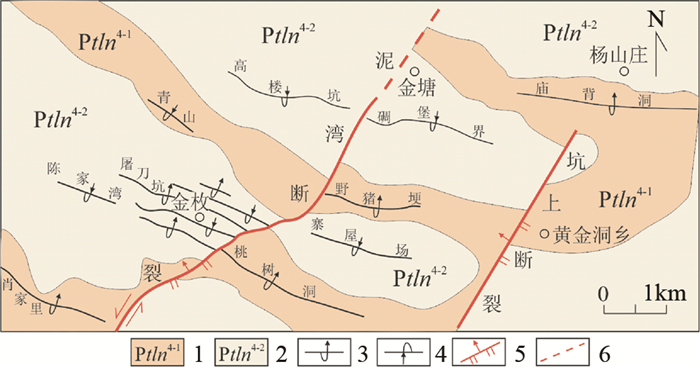
|
图 7 黄金洞矿区构造分布图 1-新元古代冷家溪群第四岩组第一岩性段; 2-新元古代冷家溪群第四岩组第二岩性段; 3-倒转背斜; 4-倒转向斜; 5-走滑断裂; 6-推测断裂 Fig. 7 The tectonic map of Huangjindong deposit 1-the Ⅰ lithologic section of Lengjiaxi Group in Neoproterozoic rocks; 2-the Ⅱlithologic section of Lengjiaxi Group in Neoproterozoic rocks; 3-overturned anticline; 4-overturned syncline; 5-strike-slip fault; 6-speculated fracture |
断裂带是印支-燕山期的多次构造运动的产物,受到不同期次构造运动叠加,使得其倾向发生局部的变化,对本区金矿床的中后期改造、叠加、富集起到了一定的作用。褶皱构造在黄金洞矿区发育极为强烈,主要由近EW-NWW向的复式向斜及一系列近似平行的次级同向倒转紧密型褶皱群组成,两翼岩层皆向北倾,南翼倾角较陡 (50°~70°),北翼倾角稍缓 (40°~50°)。在泥湾断裂带上盘有屠刀坑倒转背斜及高楼坑倒转向斜,但产状与泥湾断裂下盘的褶皱有30°交角,轴面倾角30°左右。次级揉皱和小褶曲常见,但规模较小,对矿 (化) 体形态影响较小 (图 7)。
庙背洞倒转背斜:位于矿区东部202矿脉以南,走向近东西,倾向北,出露地层为冷家溪群第四岩组第一岩性段,轴向线与矿脉露头线大致平行分布。
高楼坑-碉堡界倒转向斜:受泥湾断裂分割,分布断裂东西两侧,长约4 km,褶皱较开阔,地层为冷家溪群第四岩组第二岩性段。岩层倾向北北东,倾角40°~65°,轴向280°~290°,北翼倒转,南翼正常,轴向线与矿脉露头线大致平行分布。
野猪埂倒转背斜:分布于矿区南部、501号矿脉的北侧,走向北西西,倾向北,出露地层为冷家溪群第四岩组第一岩性段,向斜轴向线与501号矿脉大致平行分布,两者相距为100~150m。
屠刀坑倒转背斜:位于矿区西南角,东起横岭,向西经屠刀坑,在猫公石南东300m处倾没,长2300m,由冷家溪群第四岩组第二岩性段地层组成。两翼岩层次级褶皱发育,岩层倾向北北东,倾角50°~67°,轴向为280°~190°,北翼正常,南翼倒转。
2.2.2 大洞-万古金矿床位于江南造山带中段幕阜山-望湘断隆带上的大洞、万古金矿,由于二者产出位置接近、形成机理相似且部分矿脉相连在一起,故简称大万金矿 (图 1b),资源潜力可达120t。地层主要为新元古代坪原组以砂质板岩和绢云母板岩组成的浅变质碎屑岩;构造总体有NW向和NE向两组断裂,均具多期次活动的特征 (图 8);矿区内无岩浆岩体出露。经过20余年的勘查及采矿,共圈出大小12条含金构造带、金矿体48个。矿体多呈脉状、似层状或长透镜体状沿构造破碎带充填,其中的石英脉亦呈透镜状及细 (网) 脉状顺构造面分布,前者脉宽一般5~20cm。石英脉较发育处,往往金品位相对较高,局部可见明金。矿体规模明显受所在矿脉带规模制约,即矿脉带规模 (含侧伏延深) 越大,其中的矿体规模一般就越大。矿石类型主要为含金石英脉型,还有少量的蚀变岩型和构造角砾岩型 (图 9a, b)。金属矿物以毒砂和黄铁矿为主,还有少量方铅矿、闪锌矿、辉锑矿及自然金 (图 9c);脉石矿物主要为石英、方解石,此外,还有少量的绿泥石,绢云母等 (图 9d)。矿石结构有自形、他形粒状、不等粒镶嵌及碎裂结构;构造以块状、条带状、角砾状、脉状及浸染状构造为主。金主要以不可见金的形式存在于毒砂和黄铁矿之中,可见少量的自然金。围岩蚀变强烈,主要为硅化及绢云母化,黄铁矿化、毒砂化和硅化与金的矿化关系密切,叠加蚀变对成矿更为有利 (图 9e, f)。
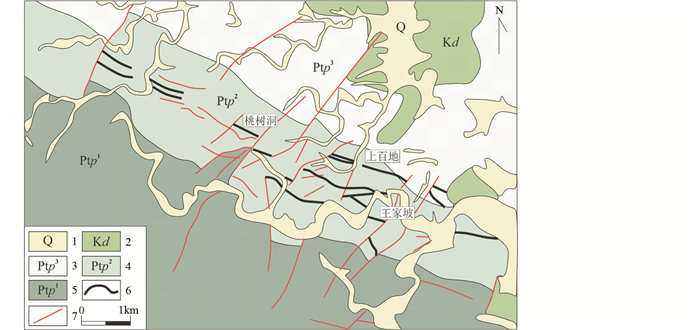
|
图 8 平江县大洞-万古金矿区地质简图 1-第四系;2-白垩纪戴家坪组;3-新元古界坪原组第三段;4-新元古界坪原组第二段;5-新元古界坪原组第一段;6-矿脉;7-断层 Fig. 8 The geological sketch of Dadong-Wangu gold deposits in Pingjiang County 1-Quaternary; 2-Cretaceous series Daijiaping Fm.; 3-the third lithologic section in Pingyuan Fm.; 4-the second lithologic section in Pingyuan Fm.; 5-the first lithologic section in Pingyuan Fm.; 6-ore veins; 7-faults |

|
图 9 大万金矿不同的矿脉类型和主要矿物特征 (a) 含金石英脉; (b) 蚀变板岩型矿脉, 矿脉受破碎带控制; (c) 位于石英脉和板岩接触带上的毒砂,较破碎,部分晶型较好, 呈菱柱状, 反光; (d) 晶型较大的方解石和石英共生, 细小的方解石脉穿插石英; (e) 颗粒较大的含金黄铁矿, 其中包含细小的毒砂; (f) 粒状的石英被方解石穿插, 不同石英颗粒以及石英和方解石的裂隙之间有较多的毒砂. Asp-毒砂; Py-黄铁矿; Cc-方解石; Q-石英; Ccp-黄铜矿; Sp-闪锌矿; Sl-板岩 Fig. 9 Photographs and photomicrographs showing the different ore veins and minerals features from Dawan gold deposit (a) gold-bearing quartz veins; (b) ore-bearing alteration slate type veins, veins are controlled by the fracture zones; (c) broken partially crystalline, under reflected light; (d) crystalline calcite and quartz larger symbiosis, interspersed with tiny quartz calcite veins, under reflected light; (e) larger particles gold-bearing pyrite, which contains fine arsenopyrite; (f) granular quartz is cut by calcite vein, arsenopyrite filled the boundary between different quartz grains or between pyrite and quartz. Asp-arsenopyrite; Py-pyrite; Cc-calcite; Q-quartz; Ccp-chalcopyrite; Sp-sphalerite; Sl-slate |
断裂是大万金矿的容矿构造,也是最主要的控矿因素。矿区位于长平断裂带的北西侧,断裂构造极其发育,主要为北东向断裂及北西西向断裂。其中北西西向的断裂为矿体的含矿构造,北东向的断裂等距离的切割矿脉 (图 10a)。通过井下观察和测量可知,含矿脉体的倾向为北东向,倾角变化较大,总体上的产状与地表所观察到的北西西走向断裂一致 (图 10a-c)。从图 10a中还可以看到,北西西走向的含矿石英脉的产状被一北东走向的断层 (产状为300°∠58°) 切割,这与图 8所示的北东走向断层切割北西西走向断层一致。矿脉形成时,矿区主体上处于挤压的构造环境,使得含矿石英脉形成较强的揉皱 (图 10a, d)。
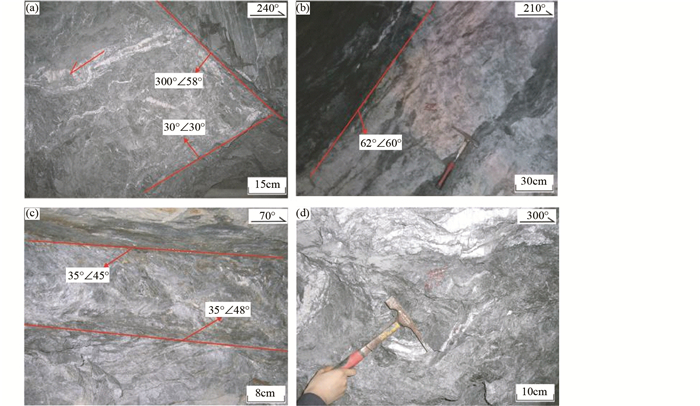
|
图 10 大万金矿脉和构造井下特征 (a) 含矿石英脉型矿脉,其中发育左旋揉皱,含矿石英脉与底板围岩的接触面的产状为30°∠30°,与北西西走向的断裂一致; 含矿石英脉被另一北东走向的断层切割,该断层的产状为300°∠58°; (b) 含矿石英脉与顶板围岩的分界面,其产状为62°∠60°; (c) 蚀变岩型矿脉,顶底板面近平行,产状分别为35°∠45°和35°∠48°; (d) 含矿石英脉发生较强的变形,形成揉皱 Fig. 10 Photographs showing the features of ore veins and the structures in Dawan gold deposit (a) auriferous quartz vein, where left crumpled development, occurrence of ore containing quartz veins and wall rock bottom contact surface of 30°∠30°, fracture consistent with the NWW trending; quartz veins containing ore by another North trending faults cut, occurrence of the fault is 300°∠58°; (b) interface ore containing quartz veins and roof rock, the occurrence of 62°∠60°; (c) altered auriferous vein, nearly parallel to the surface of the roof and floor, occurrence was 35°∠45°and 35°∠48°; (d) ore-containing quartz veins occur strong deformation & crumpled form |
浏阳井冲矿床是目前研究区探明的最大的铜多金属矿床。现今探明属于中型规模,是一个以铜为主,伴生有钴、铅、锌、硫的多金属矿床,铜平均品位为0.619%,钴平均品位为0.027%,探明的储量为98080t的铜资源,3718t的钴资源。矿区位于连云山复式背斜西侧,长平断陷盆地东南缘 (图 1b)。矿区整体上呈一不完整的单斜构造,区内构造以北北东向大致平行展布的断裂为主。矿区内出露地层主要为新元古界冷家溪群,因受构造和岩浆作用,其与连云山岩体的接触带发生强烈混合岩化,形成出露宽16~240m的混合岩带。泥盆系地层岩性为砂岩、粉砂岩、夹砂砾岩等,出露有跳马涧组 (D2t)、棋子桥组 (D2q) 和佘田桥组 (D3s)。区内共圈出铜矿体6个、钴矿体5个。矿体整体走向北东,倾向北西,倾角36°~47°,呈似层状或透镜状产出,受构造岩性控制明显,其中铜、钴矿体产于构造热液蚀变岩带的中下部。矿石类型以黄铁黄铜矿矿石、含钴黄铁黄铜矿矿石为主。矿石矿物包括黄铁矿和黄铜矿,及少量的辉铜矿、斑铜矿、毒砂、磁黄铁矿、白铁矿、辉铋矿、辉铅铋矿、辉砷钴矿等;脉石矿物有石英、绿泥石,少量的绢云母、方解石及高岭石。矿石结构有自形、半自形、他形粒状、乳滴状、交代及斑状压碎结构;矿石构造有块状、浸染状、条带状构造,其次为皮壳锒边、角砾状、脉状及网脉状构造。围岩蚀变强烈,以硅化、绿泥石化为主,次为碳酸盐化和绢云母化。矿化以黄铁矿化为主,次为黄铜矿化、毒砂矿化。
矿区构造总体为一不完整的单斜构造,它切割了冷家溪群及泥盆系地层,控制了矿区东侧燕山早期岩体的侵入,定位了动力变质带的形成、展布 (宁钧陶,2002)。其中纵贯全区的长平断裂的主干断裂F2为区域性深大断裂,属压扭性断裂,其在燕山期活动最为强烈,力学性质发生过多次转换;显微岩石组构分析资料 (许德如等,2009;宁钧陶,2002) 表明,该断裂依次发生过剪性-张性-压扭性等不同性质的构造活动,是矿区主要的控矿构造。由于F2断裂发育于两组岩性差异较大的泥盆系棋梓桥组与跳马涧组之间,致使断裂上盘的岩石形成了明显的构造挤压破碎带 (Bd;图 11a),地表出露宽度约50~160m,带内岩石片理化、糜棱岩化以及构造透镜体非常发育。岩石角砾大多呈次棱角至半浑圆状,大小约0.5~5cm,成熟度较低,但定向排列明显;成分较为复杂,有板岩、砂岩、硅质岩、石英脉、花岗岩及少量灰岩;胶结物可见片状泥质矿物。断裂下盘岩石形成构造热液蚀变岩带 (Gs;图 11a),厚度达60~130m,成分为硅质构造角砾岩、绿泥石化硅质岩、绿泥石岩及混合岩化所形成的糜棱岩。在断裂下盘,走向为35°~45°的“入”字型压扭性分支断裂构造极为发育,这与蚀变岩产状一致,总体呈现为一系列的层间剪切带,并导生出大量层间扭裂隙和张扭裂隙,构成层间构造裂隙群 (图 11b)。矿区内铜多金属矿化 (体) 均发育于此蚀变层间剪切带中,并严格受其控制。
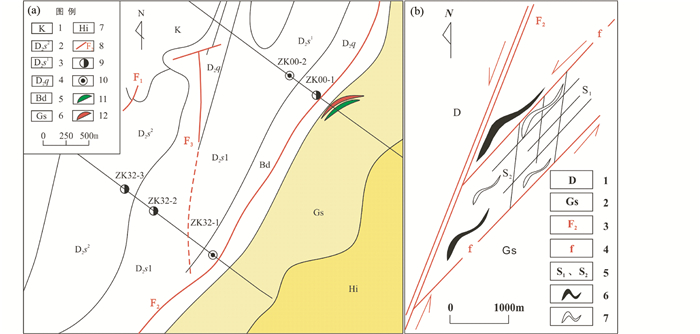
|
图 11 井冲铜钴多金属矿床地质略图 (据宁钧陶,2002修改) 图a中:1-白垩系; 2-泥盆系上统佘田桥组第二岩性段; 3-泥盆系上统佘田桥组第一岩性段; 4-泥盆系中统棋梓桥组; 5-构造挤压破碎带; 6-构造热液蚀变带; 7-混合岩带; 8-断层位置及编号; 9-见铜钴矿钻孔; 10-未见矿钻孔; 11-钴矿体; 12-铜矿体;图b中:1-泥盆纪; 2-构造热液蚀变岩带; 3-主干断裂; 4-“入”字形分支断裂; 5-张扭性断裂群; 6-铜钴矿体; 7-蚀变岩带 Fig. 11 The geological map in Jingchong copper-cobalt ore polymetallic deposit (modified after Ning, 2002) In Fig. 11a: 1-Cretaceous; 2-the second lithologic section in Shetianqiao Fm.; 3-the first lithologic section in Shetianqiao Fm.; 4-the Qiziqiao Fm.; 5-tectonic compression fracture zone; 6-tectonic hydrothermal altered rock zone; 7-migmatite zone; 8-faults positions and its number; 9-mine drilling with copper & cobalt ore; 10-the drilling without ore; 11-cobalt ore body; 12-copper ore body; In Fig. 11b: 1-Devonian; 2-tectonic hydrothermal altered rock zone; 3-major fault; 4-the branch fracture; 5-tensile-shear fracture; 6-copper & cobalt ore body; 7-alteration zones |
江南造山带形态上总体呈现NW向凸出的弧形,在湘东北一带呈现NNE向展布 (黄汲清, 1954; 任纪舜等, 1990; 李江海和穆剑, 1999)。对于该造山带的大地构造性质,国内外学者看法不一,较为流行的观点认为,在中-新元古代时,华南洋向扬子地块俯冲,导致所形成的岛弧褶皱带或多岛弧盆系 (王鸿祯, 1982, 1986;刘宝珺等, 1993;郭令智等, 1983, 1984; 徐备, 1990;殷鸿福等, 1999;尹福光等, 2003a, b;潘桂棠等, 2009);另有,由于印支-燕山运动,使得岩石圈内部拆离并向西逆冲,所形成的推覆构造体 (朱夏, 1980),裂陷环境下,由于裂谷关闭时陆块拼贴碰撞和陆内俯冲共同作用,所产生的陆内造山带 (丘元禧, 1998; 丘元禧等, 1998),过渡型的基底拆离式构造 (丁道桂和刘光祥, 2007; 丁道桂等, 2007a, b) 以及江南造山带为印支期阿尔卑斯式远程推覆体 (许靖华等,1987;Hsü et al., 1988;李继亮等, 1989;陈海泓和肖文交,1998;赵崇贺等, 1996;何科昭等, 1999)。近些年来,随着研究手段的深入 (如大量高精度锆石测年),江南造山带地质背景和构造演化研究水平有了很大提高 (王剑, 2001, 2005;柏道远等, 2007a, b, c, d;周金城等, 2005, 2008, 2009;李献华等, 2008)。江南造山带多期造山作用及其与成矿作用的关系也受到地质学者和矿床学者的广泛关注 (Li and Li, 2007;章泽军等,2003;张彦杰等,2010;Charvet et al., 1996;Shu and Charvet, 1996;Yao et al., 2015)。
矿田构造展布及矿体构造变形作用与所处地球动力学背景、构造演化、基底属性与深部构造、构造应力场及矿体周围和上覆下伏地层岩性组合等关系密切;矿体赋存状态是成矿作用和矿田演化共同改造、叠加作用的产物;大地构造演化与地壳运动时空的差异性,由此决定了矿田基底的不同,从而控制了赋矿带的形式和格架 (李四光, 1973;陈国达, 1978;曾庆丰, 1978;翟裕生,1981; 翟裕生等, 1981;杨开庆, 1982, 1986;吴淦国, 1994, 1998; 吴淦国和吕承训, 2011;斯米尔诺夫, 1981)。湘东北地区自中生代以来的构造活动,改造了矿田模式及矿体赋存状态。以中-晚三叠世为界限,华南大陆从震旦纪至今构造演化可划分成海相盆地演化 (即震旦纪-中三叠世) 和陆相盆地演化2大阶段 (即晚三叠世-第四纪) (赵宗举等, 2003),构造变形时代对应晚奥陶世-早泥盆世、三叠纪 (印支运动)、晚侏罗世-早白垩世和晚白垩世 (Wang et al., 2013b)。江南造山带中段湘东北地区矿田构造的形成是多期次构造变形和岩浆侵入作用共同的结果。通过对区内地质资料的分析及野外典型矿床的控矿构造地质勘探,初步总结了区内矿田构造的形成及演化过程,结合构造环境背景特点,将该区域构造演化分为元古代-古生代以及中生代-新生代两大演化阶段,并划分4个次级阶段展开论述。
3.1 新元古代基底形成和岩浆活动新元古代湘东北地区属于“江南古陆”的一部分,沉积了一套以陆屑复理石建造为主的岩系 (冷家溪群) 和具活动性地槽向稳定性地槽过渡特征的陆源泥砂碎屑岩、海相硅质岩、碳酸盐岩夹火山岩沉积建造 (板溪群、震旦系)。武陵运动后本区隆升为陆,在SN向挤压应力的作用下,使冷家溪群地层产生紧密线性褶皱,并遭受了区域变质作用。之后雪峰运动使冷家溪群再次发生褶皱和断裂,形成NW向构造,并伴随有一定规模的岩浆活动。区域应力场继承了武陵期的特点,并伴有SN向右型扭动。在EW向构造与NW向构造的复合交汇部位,控制了该期花岗岩体的侵入,代表性岩体有长三背、大围山、葛藤岭和板背岩体。此时,冷家溪群等地层因岩浆上涌开始了矿源层的沉积作用。
3.2 加里东运动及古亚洲大陆形成加里东运动期, 扬子与华夏地块发生碰撞拼合 (舒良树, 2006; Xu et al., 2007;Shu et al., 2008; Hsü et al., 1990;刘运黎等, 2009; 周小进和杨帆, 2009),初步形成连续统一的陆内海盆。由于加里东构造作用以近SN向的水平挤压为主,形成一系列封闭的、以EW向或近EW向为主的褶皱,以及近EW向的、呈带状分布的隆起、坳陷。地层及沉积的环境说明,大部分隆起,遭受剥蚀,仅局部发育寒武系、奥陶系及下志留统,由海相碳/硅质建造、泥质岩建造、碳酸盐岩建造等组成;中志留世后逐渐形成斜贯本区的“江南古陆”;志留纪末,由于加里东运动褶皱变形,本区EW向构造定型,NE向构造生成,同时伴有一定规模的岩浆活动,壳源型中酸性岩体较发育。与此同时,本区南侧的华南褶皱系褶皱隆起转化为地台,与扬子准地台结为一体,扩大了中国南部地台的范围,奠定了古亚洲大陆的雏形。
3.3 印支期造山作用及大陆边缘活动发生在印支运动期间的代表性构造事件有华南南部古特提斯洋的闭合及印支板块与华南陆块的碰撞。在中生代早期,由于受印支板块作用,区域构造应力场呈NW-SE方向,从而使EW向的构造变化加强及该时期的花岗岩体比较发育 (Chu et al., 2012;Wang et al., 2005, 2007a, b,2012;罗志高等,2010;陈卫锋等, 2007;王岳军等,2005)。但此时“江南古陆”中段湘东北地区处于陆内造山运动的边缘,并不是其构造的中心,从而形成一系列逆冲推覆构造,及以NEE向和NNE向为轴迹的褶皱 (李三忠等,2011;徐先兵等,2009)。在连云山地区,盖层褶皱叠加现象发育, 在地形上呈现为穹隆-盆地构造 (汪劲草等,1999;张岳桥等,2009;王建等,2010;Chu et al., 2012),穹-盆构造为早期EW向褶皱与晚期NNE向褶皱叠加的产物。作为卷入的最新地层中-下三叠统,其与上三叠统和下侏罗统为不整合接触关系,这种不整合的分布规律与加里东期不整合面的分布两者存在继承性 (陈世悦等,2011)。此时期内,区域构造应力场以SN向左型扭力为主,SN向挤压继续活动,但强度减弱;在这种应力场的作用和影响下,产生一系列NE向褶皱 (开阔、平缓)、韧性剪切带、逆冲叠瓦式断裂,组成一系列NE向构造带。如浏阳-醴陵-衡东叠瓦式逆冲断层,中部发育隔档式褶皱,整体呈NW向逆冲,形成了研究区的基本构造格局。印支运动强烈的褶皱造山作用,使本区及邻区隆起成陆,结束了长期海浸的历史,进入了全新的大陆边缘活动阶段。
3.4 燕山期构造转换与成矿作用受燕山期构造应力作用,研究区现今构造框架基本确定 (朱锐等,2006),早期,以挤压作用为主,形成一系列以下侏罗统-三叠系及其下伏的地层为核部的紧闭的褶皱。由于区域构造应力场的主压应力方向为NWW向,使得早先形成的一系列EW、NE向断裂以及NW向断裂带再次发生强烈运动并改造、复合,形成了新的切层逆冲断层,从而先前形成的褶皱得到改造并加强。最后,形成了著名的湘东NNE向“多”字型构造体系。太平洋构造域受NW-SE向的挤压应力作用,使“江南古陆”陆内作用的构造变形得到进一步发展。早-中侏罗世为特提斯构造域向古太平洋构造域转变期,早白垩世基本完成从特提斯向古太平洋体系的转换,转变为板内裂谷拉张 (舒良树,2012;柏道远等, 2007a, 2008)。伸展作用使沉积盖层沿加里东期不整合面向SE滑移,在研究区西部形成滑覆构造,如推覆构造等,亦形成一系列白垩系断陷盆地,如汨罗盆地。湘东北在印支期转入陆内活化阶段后,多期中酸性岩浆活动强烈发育,可分为燕山早期 (151~144Ma) 和燕山晚期 (140~128Ma) 两个主要侵入期 (贾大成和胡瑞忠, 2002; 贾大成等,2003)。此外,还见燕山晚期的以辉绿岩和煌斑岩为代表的多期基性岩脉 (ca. 136~86Ma) 在区域内呈岩带或岩群出露 (贾大成等,2002)。岩石地球化学特征表明湘东北经历了燕山早期的剪切-走滑到燕山晚期的伸展-滑脱构造转折 (贾大成和胡瑞忠, 2002; 贾大成等, 2002, 2003)。伴随着上述岩浆-构造事件,金、钴、铜多金属和稀有金属成矿作用广泛发育,构成华南中生代醒目的北东向构造-岩浆成矿带,这一成矿事件多与燕山晚期岩石圈的伸展-减薄作用相关 (贾大成等,2003)。
4 湘东北地区构造演化与成矿响应从区域构造演化及典型矿床类型的划分与控矿构造特征可以看出,湘东北矿田内不同类型的矿床是总体上是受NE (NNE) 向构造为主导的复合改造EW及近EW向构造的交汇部位控制,断裂破碎带及次级裂隙是矿体主要赋存位置。
4.1 元古代-古生代构造是矿田构造变形基础燕山前期形成的构造主要有东西向构造、北西向构造及北东向构造。发育的东西向构造主要为宁乡-浏阳东西向构造带,由呈东西向的褶皱、断裂及武陵期、雪峰期和加里东期中酸性岩体组成,成群成带展布。由于受晚期北 (北) 东向构造的叠加、肢解作用,东西向构造带被切割成条条块块,局部甚至迁就北东向构造而呈弧形或北东东向展布。褶皱呈紧密线性形态;断裂构造主要由压性及压扭性断裂组成,具有多期活动的特征。东西向构造断裂带对雪峰期岩体 (如长三背、大围山)、加里东期岩体 (如张坊) 以及燕山早期岩体 (如东茅山岩体;图 12) 的产出均有明显的控制作用,使这些岩体均呈东西向展布。从褶皱卷入的地层及断裂发育特点和雪峰期-加里东期岩体的展布来看,该东西向构造生于武陵期,定型于加里东期,燕山期仍有活动。北西向构造的展布,以长平断裂带为界,东、西两侧有一定差别:东侧表现明显,褶皱和断裂均有发育;西侧则主要为断裂且不甚发育。褶皱多由冷家溪群构成一系列北西走向的倒转紧闭褶皱,地层层面多倾向北东,并控制了武陵期-燕山期岩浆岩的展布方向。根据岩石变形和组构分析,存在一组北西向韧性变形带和韧性剪切带,西自瓮江、万古,跨过长平盆地和连云山岩体并逐渐与东西向构造联合。在平江万古一带主要表现为近乎顺层的韧性变形带,是万古金矿的重要容矿构造。而在黄金洞一带则表现为韧性剪切带,控制了金矿脉的产出。北西向构造主要发育于冷家溪群中,从褶皱卷入的地层及被北东向断裂所改造来看,其成生早于北东向构造,在燕山期前即已形成,在燕山早期受北东向构造改造,其力学性质转为张性,并与其他构造联合控制了本区金矿床的形成和展布。北东向构造由于受到晚期北北东断裂的干扰和长平盆地的分割,其构造形迹连续性较差。从褶皱卷入的地层来看,其形成于燕山前期,以印支期为主要活动时期。该方向断裂构造受燕山早期北北东向构造的继承和叠加,活动有所加强。其力学性质燕山前期主要为压性,部分断裂早期具张性特征,为北西向构造的配套成分。
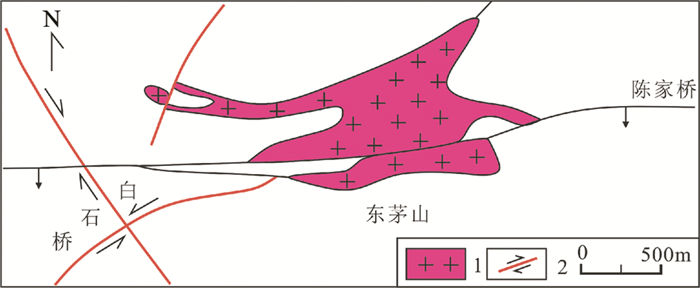
|
图 12 湘东北地区东茅山控岩构造图 1-燕山早期花岗岩; 2-断层 Fig. 12 Sketch map showing the rock-controlling structure of the Dongmaoshan in northeastern Hunan 1-Early Yanshan granitoid; 2-faults |
自燕山期以来,由于大平洋板块向欧亚板块的俯冲作用使本区形成一系列北北东向右形斜列的断陷盆地与断裂隆起带,自西往东依次为:幕阜望湘断隆带、长平断隆带、浏阳-衡东断隆带。 同时,强大的北北东向构造作用,对先存北东向构造(带),东西向构造(带)和北西向构造(带)进行继承和复合改造,使本区形成了以东西向构造为基础、北(北)东向构造为主导、北西向构造为次的构造格架。
4.2.1 北北东向断裂的压扭性活动该方向断裂发育,普遍见其切割东西向构造和北西向构造,部分切割北东向断裂。其重要特点是燕山早期表现为压性特征,同期岩体如金井、石蛤蟆、鳌鱼山等均与之活动密切相关,或受其控制,或沿断裂侵入。该方向断裂燕山晚期往往表现为张性活动。
4.2.2 北东向断裂的继承、复合特点燕山早期部分构造应力沿前期北东向压扭性构造薄弱带释放,其结果该方向断裂仍表现为压扭性,且有所加强。湘东北地区燕山早期所发育的一些北北东或北东向断裂就是在继承、沿袭利用一部分北东向断裂的基础上发展起来的。总体走向为北东向的长平断裂带是区内重要的控岩控矿断裂构造,其对燕山早期岩体 (脉) 的侵入和井冲 (普乐)、横洞、东冲等热液脉型Cu、Pb、Zn、Co矿床具有重要的控制作用。如介于连云山-蕉溪岭复背斜与长平断陷盆地之间长平断裂带,总体呈北东20°~30°走向纵贯全区,由数条时分时合的压扭性断裂及其间所夹动力变质岩带组成。前人通过对长平断裂带的构造演化进行研究,发现该断裂在中侏罗世早期和晚期先后发生了脆性剪切变形,其中早期伴随花岗岩体的侵入形成了蚀变带,并叠加了混合岩化;晚期则产生了次级断裂破碎带和低序次的构造裂隙群,成为含矿热液充填的良好的场所,随之而来的花岗岩侵入则提供了主要矿质来源。
4.2.3 东西向构造的张扭性改造东西向断裂在燕山早期除被北 (北) 东向断裂切割外,还表现为力学性质的改变,发育张性构造角砾岩。它控制了七宝山岩体的侵入和定位,同时也对矿体起着控制作用。该断裂局部地段被北东向断裂切割改造后,走向也发生了改变,转为北东东向。
4.2.4 北西向构造的张性改造燕山早期NWW向主压应力作用的结果,必然使北西向断裂发生张性改造,表现为早期压性、晚期张性的力学性质变化的特点,为本区金矿床的形成提供了有利的容矿空间。
以上这些多期次的叠加构造为湘东北地区矿床的形成和展布提供了动力条件。
4.3 区域成矿作用探讨江南造山带中的金及金多金属矿床成矿作用特殊,是我国一个典型的金多金属矿床成矿带。按照矿床地质特征、结合区域构造演化,兹提出区域矿床成矿模式 (图 13)。

|
图 13 江南造山带中段湘东北地区金及金多金属矿床成矿模式 1-花岗岩;2-断裂;3-韧性剪切带;4-金矿;5-铜多金属矿 Fig. 13 The metallogenic model of Au and Au-polymetallic mineralization in the domain in northeastern Hunan Province, Jiangnan Orogen 1-granitoid; 2-faults; 3-ductile shear zone; 4-gold ore deposit; 5-copper polymetallic ore deposit |
湘东北地区金及金多金属成矿作用过程可划分为三个期次:新元古代矿源层沉积期 (ca.860~820Ma)、加里东期-印支期变质改造期 (ca. 820~400Ma)、燕山期岩浆热液成矿期 (ca. 140Ma),其中燕山期热液成矿期为主成矿期。燕山期构造活动形成的北东向长平断裂带,不仅为含矿流体向上运移提供了通道,而且有利于岩体的侵入。含矿流体通过进一步萃取、淋滤地层中的有用成矿元素,形成了富Au、Cu等多金属的成矿热液,这些含矿热液沿有利的构造部位发生沉淀从而富集成矿。
5 结论(1) 湘东北地区矿田构造主要是由NE (NNE) 向构造为主导的复合改造EW及近EW向构造组成,多期次构造活动造就了该区以NW为走向的褶皱,及NE向断裂体系,形成了以“两隆三盆”为特征的含矿构造格局;
(2) 印支期以来的挤压应力场是湘东北地区构造格局形成的关键,燕山期的伸展作用则使该区成矿物质发生富集成矿;
(3) 湘东北地区构造格局呈现东西分带的特征 (以长平断裂带为界):东侧褶皱和断裂非常发育,西侧则主要为断裂且发育不明显。褶皱主要由冷家溪群地层构成的、一系列以NW为走向的倒转紧闭褶皱,地层层面多倾向NE,并控制了武陵期-燕山期岩浆岩的展布;
(4) 湘东北地区矿床构造以韧性剪切控矿构造样式为主;
(5) 矿体赋存状态与构造时空演化及构造组合密切相关,构造变形叠加、改造及其互相制约,共同控制了矿产资源的现今赋存状况。
(6) 提出了江南造山带中段湘东北地区金及金多金属矿床成矿模式图。
致谢 两位匿名评审者提出的建议和意见促进了本文质量的提高,作者表示致谢!| [] | Bai DY, Huang JZ, Li JD, Wang XH, Ma TQ, Zhang XH, Chen BH. 2007a. Multiple geological elements constraint on the Mesozoic tectonic evolution of South China: Apocalypse of the Mesozoic geological evolution in southeastern Hunan and the Hunan-Guangdong-Jiangxi border area. Geotectonica et Metallogenia, 31(1): 1–13. |
| [] | Bai DY, Zhou L, Wang XH, Zhang XY, Ma TQ. 2007b. Geochemistry of Nanhuan-Cambrian sandstones in southeastern Hunan, and its constraints on Neoproterozoic-Early Paleozoic tectonic setting of South China. Acta Geologica Sinica, 81(6): 755–771. |
| [] | Bai DY, Zhou L, Ma TQ, Wang XH. 2007c. Genesis and tectonic setting of indosinian granites in Southeast Hunan. Acta Petrologica et Mineralogica, 26(3): 197–212. |
| [] | Bai DY, Jia BH, Ma TQ, Wang XH, Zhang XY, Chen BH. 2007d. Relationship of petro-geochemical characteristics to metallogenic capacity differences between Indosinian and Early Yanshanian granites in southeastern Hunan. Acta Petrologica et Mineralogica, 26(5): 387–398. |
| [] | Bai DY, Li JQ, Zhou KJ, Ma TQ, Wang XH. 2008. Query of Qiyang e-type tectonic system in Hunan. Geotectonica et Metallogenia, 32(3): 265–275. |
| [] | Bai DY, Jia BH, Liu W, Chen BH, Liu YR, Zhang XY. 2010. Zircon SHRIMP U-Pb dating of the igneous rocks from Chengbu, Hunan: Constraint on the Neoproterozoic tectonic evolution of the Jiangnan orogenic belt. Acta Geologica Sinica, 84(12): 1715–1726. |
| [] | Bai DY, Jia BH, Zhong X, Jia PY, Liu YR, Ma TQ. 2011. Neoproterozoic tectonic evolution of the Xuefeng orogenic zone in Hunan. Sedimentary Geology and Tethyan Geology, 31(3): 78–87. |
| [] | Bai DY, Jia BH, Zhong X, Liu YR, Jia PY, Huang WY. 2012. Study on the deformation of Indosinian Movement in southeastern Hunan. Geological Review, 58(1): 19–29. |
| [] | Bai DY, Xiong X, Yang J, Zhong X, Jia PY, Huang WY. 2014. Geological structure characteristics of the middle segment of the Xuefeng orogen. Geology in China, 41(2): 399–418. |
| [] | Bin Q, Gong YH. 2003. The nappe structure in eastern Hunan Province and its significance of coal search. Coal Geology of China, 15(1): 14–15. |
| [] | Bureau of Geology and Mineral Resources of Hunan Province. 1988. Regional Geology of Hunan Province. Beijing: Geological Publishing House: 1-664. |
| [] | Charvet J, Shu LS, Shi YS, Guo LZ, Faure M. 1996. The building of South China: Collision of Yangzi and Cathaysia blocks, problems and tentative answers. Journal of Southeast Asian Earth Sciences, 13(3-5): 223–235. DOI:10.1016/0743-9547(96)00029-3 |
| [] | Chen GD. 1978. Tectonic-Methods. Beijing: Geological Publishing House. |
| [] | Chen HH, Xiao WJ. 1998. Archipelago orogenesis: Examples from Indosinian orogenic belts in South China. Earth Science Frontiers, 5(Suppl.): 95–102. |
| [] | Chen JF, Jahn BM. 1998. Crustal evolution of southeastern China: Nd and Sr isotopic evidence. Tectonophysics, 284(1-2): 101–133. DOI:10.1016/S0040-1951(97)00186-8 |
| [] | Chen PR, Kong XG, Wang YX, Ni QS, Zhang BT, Ling HF. 1999. Rb-Sr isotopic dating and significance of Early Yanshanian bimodal volcanic-intrusive complex from south Jiangxi Province. Geological Journal of China Universities, 5(4): 378–383. |
| [] | Chen PR, Hua RM, Zhang BT, Lu JJ, Fan CF. 2002. Early Yanshanian post-orogenic granitoids in the Nanling region. Science in China (Series D), 45(8): 755–768. |
| [] | Chen SY, Li C, Zhang PF, Wang YJ. 2011. The unconformable distribution of Caledonian and Indosinian strata in Jiangnan-Xuefeng area. Geology in China, 38(5): 1212–1219. |
| [] | Chen WF, Chen PR, Huang HY, Ding X, Sun T. 2007. Chronological and geochemical studies of granite and enclave in Baimashan pluton, Hunan, South China. Science in China (Series D), 50(11): 1606–1627. DOI:10.1007/s11430-007-0073-1 |
| [] | Chen X, Rong JY. 1999. From biostratigraphy to tectonics with Ordovician and Silurian of South China as an example. Geoscience, 13(4): 385–389. |
| [] | Chen X, Wang D, Wang XL, Gao JF, Shu XJ, Zhou JC, Qi L. 2014. Neoproterozoic chromite-bearing high-Mg diorites in the western part of the Jiangnan orogen, southern China: Geochemistry, petrogenesis and tectonic implications. Lithos, 200-201: 35–48. DOI:10.1016/j.lithos.2014.04.007 |
| [] | Chu Y, Faure M, Lin W, Wang QC. 2012. Early Mesozoic tectonics of the South China block: Insights from the Xuefengshan intracontinental orogen. Journal of Asian Earth Sciences, 61: 199–220. DOI:10.1016/j.jseaes.2012.09.029 |
| [] | Deng T, Xu DR, Chi GX, Wang ZL, Jiao QQ, Ning JT, Dong GJ, Zou FH. 2017. Geology, geochronology, geochemistry and ore genesis of the Wangu gold deposit in northeastern Hunan Province, Jiangnan Orogen, South China. Ore Geology Reviews. DOI:10.1016/j.oregeorev.2017.01.012 |
| [] | Deng XG, Chen ZG, Li XH, Liu DY. 2004. SHRIMP U-Pb zircon dating of the Darongshan-Shiwandashan granitoid belt in southeastern Guangxi, China. Geological Review, 50(4): 426–432. |
| [] | Ding DG, Guo TL, Hu MX, Liu YL. 2007a. Basement decoupling structure in Jiangnan-Xuefeng: Series 1 of the southern structure studies. Petroleum Geology and Experiment, 29(2): 120–127. |
| [] | Ding DG, Liu GX. 2007b. Progressive deformation in Yangtze plate: Series 2 of the southern structure studies. Petroleum Geology & Experiment, 29(3): 238–246. |
| [] | Ding DG, Guo TL, Liu YL, Zhai CB. 2007c. Structural attribute of the Jiangnan-Xuefengshan belt, China: A discussion. Geological Bulletin of China, 26(7): 801–809. |
| [] | Fan WM, Wang YJ, Guo F, Peng TP. 2003. Mesozoic mafic magmatism in Hunan-Jiangxi provinces and the lithospheric extension. Earth Science Frontiers, 10(3): 159–169. |
| [] | Fu GG, Xu DR, Chen GH, Li PC. 2002. New recognitions on geological characteristics of gold ore deposits in northeastern Hunan Province, China and new prospecting advances. Geotectonica et Metallogenia, 26(4): 416–422. |
| [] | Fu GZ. 2001. Geological characteristics of cobalt polymetallic deposit and its prospecting index at Puduo, Liuyang. Hunan Geology, 20(4): 263–266. |
| [] | Fu ZR, Li ZJ, Zhen DY. 1999. Structural pattern and tectonic evolution of NNE-trending strike-slip orogenic belt in the border region of Hu'nan-Jiangxi provinces. Earth Science Frontiers, 6(4): 263–272. |
| [] | Gilder SA, Gill J, Coe RS, Zhao XX, Liu ZW, Wang GX, Yuan KR, Liu WL, Kuang GD, Wu HR. 1996. Isotopic and paleomagnetic constraints on the Mesozoic tectonic evolution of South China. Journal of Geophysical Research, 101(B7): 16137–16154. DOI:10.1029/96JB00662 |
| [] | Guo F, Fan WM, Lin G, Lin YX. 1997. Sm-Nd isotopic age and genesis of gabbro xenoliths in Daoxian County, Hunan Province. Chinese Science Bulletin, 42(21): 1814–1817. DOI:10.1007/BF02882650 |
| [] | Guo LZ, Shi YS, Ma RS. 1983. On the formation and evolution of the Mesozoic-Cenozoic active continental margin and island arc tectonics of the western Pacific ocean. Acta Geologica Sinica, 57(1): 11–21. |
| [] | Guo LZ, Shi YS, Ma RS, Ye SF, Lu HF. 1984. Tectonostratigraphic terranes of Southeast China. Journal of Nanjing University (Natural Science Edition), 20(4): 732–739. |
| [] | He KS. 1986. New progress in the study of the regional geology of Hunan. Geological Bulletin of China(3): 204–210. |
| [] | He KZ, Zhao CH, Le CS, Zhou ZG, Nie ZT, Tai DQ, Ye N. 1999. Reexamination and impressions on "Banxi Group". Earth Science Frontiers, 6(4): 353–362. |
| [] | Hsü KJ, Sun S, Li JL. 1987. Orogenic belt in southern Taiwan rather than China South. China in Science (Series B)(10): 1107–1115. |
| [] | Hsü KJ, Sun S, Li JL, Chen HH, Pen HP, Sengor AMC. 1988. Mesozoic overthrust tectonics in South China. Geology, 16(5): 418–421. DOI:10.1130/0091-7613(1988)016<0418:MOTISC>2.3.CO;2 |
| [] | Hsü KJ, Li JL, Chen HH, Wang QC, Shu S, Şengör AMC. 1990. Tectonics of South China: Key to understanding West Pacific geology. Tectonophysics, 183(1-4): 9–39. DOI:10.1016/0040-1951(90)90186-C |
| [] | Huang JQ. 1954. On Major Tectonic Forms of China. Beijing: Geological Publishing House: 4-73. |
| [] | Huang JY. 1997. Geological feature of east-west trend group of lodes and prospecting direction. Hunan Geology, 16(3): 159–162. |
| [] | Jia DC, Hu RZ. 2002. Tectonic setting discrimination of Late Yanshanian granites in Northeast Hunan Province. Geology-Geochemistry, 30(2): 10–14. |
| [] | Jia DC, Hu RZ, Xie GQ. 2002. Trace element geochemical characteristics and genesis of Mesozoic mafic dikes in Northeast Hunan Province. Geology-Geochemistry, 30(3): 33–39. |
| [] | Jia DC, Hu RZ, Zhao JH, Xie GQ. 2003. Lithogeochemical characteristics of the Mesozoic granitic intrusion from the Wangxiang area in northeastern Hunan Province and its tectonic setting. Acta Geologica Sinica, 77(1): 98–103. |
| [] | Jin WQ, Liu HQ, Zhang LX, Shen KF. 2000. Study on rock-and ore-controlling structurs in northeastern Hunan Province. Geology and Mineral Resources of South China(2): 51–57. |
| [] | John BM, Zhou XH, Li JL. 1990. Formation and tectonic evolution of southeastern China and Taiwan: Isotopic and geochemical constraints. Tectonophysics, 183(1-4): 145–160. DOI:10.1016/0040-1951(90)90413-3 |
| [] | Li JH, Mu J. 1999. Tectonic constraints from Chinese cratonic blocks for the reconstruction of rodinia. Scientia Geplogica Sinica, 34(3): 259–272. |
| [] | Li JL, Sun S, Xu JH, Chen HH, Peng HB, Wang QC. 1989. New evidences about the evolution of the South Cathay Orogenic belt. Scientia Geplogica Sinica, 24(3): 217–225. |
| [] | Li PC, Xu DR, Chen GH, Xia B, He ZL, Fu GZ. 2005. Constraints of petrography, geochemistry and Sr-Nd isotopes on the Jinjing granitoids from northeastern Hunan Province, China: Implications for petrogenesis and geodynamic setting. Acta Petrologica Sinica, 21(3): 921–934. |
| [] | Li SG. 1973. Tectonic and crustal movement. Science in China (Series A)(4): 400–429. |
| [] | Li SZ, Wang T, Jin C, Dai LM, Liu X, Zhou XJ, Wang YJ, Zhang GW. 2011. Features and causes of indosinian intracontinental structures in the Xuefengshan precambrian basement and its neighboring regions. Journal of Jilin University (Earth Science Edition), 41(1): 93–105. |
| [] | Li XF, Li JW, Zhou MF. 2001. Field structural-lithofacie zones for shear remelt granite of Lianyunshan in Hunan Province. Geological Science and Technology Information, 20(3): 27–30. |
| [] | Li XH. 1999. U-Pb zircon ages of granites from the southern margin of the Yangtze Block: Timing of Neoproterozoic Jinning Orogeny in SE China and implications for Rodinia Assembly. Precambrian Research, 97(1-2): 43–57. DOI:10.1016/S0301-9268(99)00020-0 |
| [] | Li XH, Wang XC, Li XW, Li ZX. 2008. Petrogenesis and tectonic significance of Neoproterozoic basaltic rocks in South China: From orogenesis to intracontinental rifting. Geochimica, 37(4): 382–398. |
| [] | Li ZX, Li XH, Kinny PD, Wang J. 1999. The breakup of Rodinia: Did it start with a mantle plume beneath South China?. Earth and Planetary Science Letters, 173(3): 171–181. DOI:10.1016/S0012-821X(99)00240-X |
| [] | Li ZX, Li XH. 2007. Formation of the 1300-km-wide intracontinental orogen and postorogenic magmatic province in Mesozoic South China: A flat-slab subduction model. Geology, 35(2): 179–182. DOI:10.1130/G23193A.1 |
| [] | Liu BQ, Yu GM, Xu Q, Einsele G, Frisch W, Liu GH, Wendt J, Wetzel A, Ratschbacher L, Luterbacher HP. 1993. Formation and evolution of the Mesozoic and Cenozoic deep-water sedimentary basins along the Yarlung Zangbo river (Ⅰ): Sedimentary characteristics and evolution of the himaiayan orogenic zone. Sedimentary Facies and Palaeogeography, 13(1): 32–49. |
| [] | Liu DR, Wu YZ, Liu SN. 1994. Geochemistry of Wangu gold deposit. Hunan Geology, 13(2): 83–90. |
| [] | Liu ES, Li SZ, Jin C, Dai LM, Liu B, Zhang GW. 2010. Yanshanian structural deformation and dynamics of the Xuefengshan intracontinental tectonic system. Marine Geology & Quaternary Geology, 30(5): 63–74. |
| [] | Liu HQ, Jin WQ, Zhang LX, Shen KF. 2001. Discussion on sources of metallogenetic materials of porphyry-type and hydrothermal copper deposits in northeastern Hunan Province. Geology and Mineral Resources of South China, 17(1): 40–47. |
| [] | Liu LM, Peng SL, Wu YZ. 1997. Features of metallogenic-tectonics and mechanism of tectonic-metallization for vein-type gold deposits in the northeastern Hunan, China. Geotectonica et Metallogenia, 21(3): 197–204. |
| [] | Liu LM, Peng SL, Wu YZ. 1999. Genetic features forming vein type gold deposits in northeastern Hunan. Journal of Central South University of Technology, 30(1): 4–7. |
| [] | Liu YC. 1989. Geochemical signatures of the Huangjindong gold deposit. Geology and Prospecting(11): 43–48. |
| [] | Liu YJ, Sun CY, Cui WD, Ji JF. 1989. Study on the occurrence of gold in arsenopyrite of Huang-Jindong gold deposit in Hunan Province. Contributions to Geology and Mineral Resources Research, 4(1): 42–49. |
| [] | Liu YJ, Ma DS. 1991. Gold Geochemistry. Beijing: Science Press. |
| [] | Liu YJ, Li Y, Qiu DT, Ji JF. 1993. Ore-controlled mechanism and geochemical characteristics of gold-bearing formation in Northwest Jiangxi terrain. Science in China (Series B), 36(10): 1263–1275. |
| [] | Liu YL, Zhou XJ, Liao ZT, Yang F. 2009. Relative blocks and convergence process during the Caledonian Movement in South China. Petroleum Geology & Experiment, 31(1): 19–25. |
| [] | Luo XL. 1988. On the genesis and metallogenic model of the Huangjindong gold deposit from Hunan. Journal of Guilin College of Geology, 8(8): 225–240. |
| [] | Luo XL. 1990. On the source of ore-forming substances of Precambrian gold deposits in Hunan Province. Journal of Guilin Institute of Metallurgy and Geology, 10(1): 13–26. |
| [] | Luo ZG, Wang YJ, Zhang FF, Zhang AM, Zhang YZ. 2010. LA-ICPMS zircon U-Pb dating for Baimashan and Jintan Indosinian granitic plutons and its petrogenetic implications. Geotectonica et Metallogenia, 34(2): 282–290. |
| [] | Luo ZL, Liu SG. 2002. Comments on the citation of the term "foreland basin" in the petroliferous basins of central and western China: A review on the development of Chinese petroleum tectonics. Geological Review, 48(4): 398–407. |
| [] | Ma DS, Liu YJ. 1992. Geochemical characteristics and genesis of stratabound gold deposits in Jiangnan gold metallogenic belt. Science in China (Series B), 35(2): 240–256. |
| [] | Mao JW, Li HY. 1997. Research on genesis of the gold deposits in the Jiangnan terrain. Geochimica, 26(5): 71–81. |
| [] | Ning JT. 2002. Analysis on metallogenic geologic conditions of original co-deposits in Northeast Hunan. Hunan Geology, 21(3): 192–195. |
| [] | Pan GT, Xiao QH, Lu SN, Deng JF, Feng YM, Zhang KX, Zhang ZY, Wang FG, Xing GF, Hao GJ, Feng YF. 2009. Division of tectonic units in China. Geology in China, 36(1): 1–28. |
| [] | Peng B, Huang RH. 1996. Tectono-metallogenetic mechanism for vein-type gold ore deposits occurring in the Pre-Cambrian, Hunan Province. Geotectonica et Metallogenia, 20(3): 201–211. |
| [] | Pirajno F, Bagas L. 2002. Gold and silver metallogeny of the South China fold belt: A consequence of multiple mineralizing events?. Ore Geology Reviews, 20(3-4): 109–126. DOI:10.1016/S0169-1368(02)00067-7 |
| [] | Qiu YX. 1998. On compounding tectonics. Journal of Geomechanics, 4(1): 1–12. |
| [] | Qiu YX, Zhang YC, Ma WP. 1998. Tectonics and geological evolution of Xuefengintra continental Orogene, South China. Geological Journal of China Universities, 4(4): 432–433. |
| [] | Rao JR. 1993. South China, the Yangtze microplate ancient subduction-collision tectonic model. In: Chinese Geophysical Society Ninth Annual Conference Proceedings. Beijing: Chinese Geophysical Society, 1-45 (in Chinese) |
| [] | Ren JS, Chen TY, Niu BG, Liu ZG, Liu FR. 1990. Tectonic Evolution and Mineralization in Eastern China and Adjacent Areas of the Continental Lithosphere. Beijing: Science Press: 1-205. |
| [] | Shu L, Charvet J. 1996. Kinematics and geochronology of the Proterozoic Dongxiang-Shexian ductile shear zone: With HP metamorphism and ophiolitic melange (Jiangnan Region, South China). Tectonophysics, 267(1-4): 291–302. DOI:10.1016/S0040-1951(96)00104-7 |
| [] | Shu LS. 2006. Predevonian tectonic evolution of South China: From Cathaysian block to Caledonian Period folded orogenic belt. Geological Journal of China Universities, 12(4): 418–431. |
| [] | Shu LS, Faure M, Wang B, Zhou XM, Song B. 2008. Late Palaeozoic-Early Mesozoic geological features of South China: Response to the Indosinian collision events in Southeast Asia. Comptes Rendus Geoscience, 340(2-3): 151–165. DOI:10.1016/j.crte.2007.10.010 |
| [] | Shu LS. 2012. An analysis of principal features of tectonic evolution in South China Block. Geological Bulletin of China, 31(7): 1035–1053. |
| [] | Smirnov BH. 1981. Source endogenous metal mineral deposits in the history of the evolution of the Earth's crust in the process. Mineral Source of Endogenous Gold Deposit. In: Qin GG, (Trans.). Beijing: Geological Publishing House (in Chinese) |
| [] | Tong QM. 1998. Forming condition of large-size Au-Cu deposits in northeastern Hunan and opinions for the future work. Hunan Geology, 17(1): 19–22. |
| [] | Wang CL, Yan DP, Zhang B, Xu YB, Tang SL. 2011. Structural style and deformational characteristics of the thick-skinned thrust belt in the western Xuefeng Mountain. Geoscience, 25(6): 1021–1031. |
| [] | Wang DZ, Shu LS, Faure M, Sheng WZ. 2001. Mesozoic magmatism and granitic dome in the Wugongshan Massif, Jiangxi Province and their genetical relationship to the tectonic events in Southeast China. Tectonophysics, 339(3-4): 259–277. DOI:10.1016/S0040-1951(01)00130-5 |
| [] | Wang DZ. 2004. The study of granitic rocks in South China: Looking back and forward. Geological Journal of China Universities, 10(3): 305–314. |
| [] | Wang GP. 1983. Discussion on the basic characteristics of the Indo-Sinian Movement in Fujian Province. Geology of Fujian, 2(2): 27–36. |
| [] | Wang HZ. 1982. The main stages of crustal development of China. Earth Science(3): 155–178. |
| [] | Wang HZ. 1986. Precambrian geochronologic and chronostratigraphic subdivision of China. Earth Sciences, 11(5): 447–453. |
| [] | Wang J. 2000. Neoproterozoic rift basin evolution: On the relationship between Rodinia breakup. In: Tectonic Evolution of Ancient Chinese Land Mass Super Cycle Thematic Conference Abstracts Collection and Mainland. Beijing: Geological Society of China, 3-78 (in Chinese) |
| [] | Wang J. 2001. South China Neoproterozoic rift basin evolution: On the relationship with the Rodinia breakup. In: Summary Proceedings of the National Congress of Sedimentary Geology. Beijing: Geological Society of China, 2-90 (in Chinese) |
| [] | Wang J. 2005. New advances in the study of "the Nanhuaan system": With particular reference to the stratigraphic division and correlation of the Nanhuaan System, South China. Geological Bulletin of China, 24(6): 491–495. |
| [] | Wang J, Li SZ, Jin C, Wang YJ, Zhang GW, Liu LP, Liu X. 2010. Dome-and-basin pattern in central Hunan Province: Stages and genesis of fold superposition. Geotectonica et Metallogenia, 34(2): 159–165. |
| [] | Wang JC, Peng ES, Sun ZJ, Tang SJ. 1999. Tectonic evolution of Longshan dome in middle Hunan. Hunan Geology, 18(4): 229–231. |
| [] | Wang YJ, Fan WM, Guo F, Li HM, Liang XQ. 2002. U-Pb dating of Early Mesozoic granodioritic intrusions in southeastern Hunan Province, South China and its petrogenetic implications. Science in China (Series D), 45(3): 280–288. DOI:10.1360/02yd9030 |
| [] | Wang YJ, Zhang YH, Fan WM, Xi XW, Guo F, Lin G. 2002. Numerical modeling of the formation of Indo-Sinian peraluminous granitoids in Hunan Province: Basaltic underplating versus tectonic thickening. Science in China (Series D), 45(11): 1042–1056. DOI:10.1007/BF02911241 |
| [] | Wang YJ, Zhang YH, Fan WM, Peng TP. 2005. Structural signatures and 40Ar/39Ar geochronology of the Indosinian Xuefengshan tectonic belt, South China Block. Journal of Structural Geology, 27(6): 985–998. DOI:10.1016/j.jsg.2005.04.004 |
| [] | Wang YJ, Fan WM, Liang XQ, Peng TP, Shi YM. 2005. SHRIMP zircon U-Pb geochronology of Indosinian granites in Hunan Province and its petrogenetic implications. Chinese Science Bulletin, 50(13): 1359–1403. |
| [] | Wang YJ, Fan WM, Sun M, Liang XQ, Zhang YH, Peng TP. 2007a. Geochronological, geochemical and geothermal constraints on petrogenesis of the Indosinian peraluminous granites in the South China Block: A case study in the Hunan Province. Lithos, 96(3-4): 475–502. DOI:10.1016/j.lithos.2006.11.010 |
| [] | Wang YJ, Fan WM, Zhao GC, Ji SC, Peng TP. 2007b. Zircon U-Pb geochronology of gneissic rocks in the Yunkai massif and its implications on the Caledonian event in the South China Block. Gondwana Research, 12(4): 404–416. DOI:10.1016/j.gr.2006.10.003 |
| [] | Wang YJ, Zhang AM, Cawood PA, Fan WM, Xu JF, Zhang GW, Zhang YZ. 2013a. Geochronological, geochemical and Nd-Hf-Os isotopic fingerprinting of an Early Neoproterozoic arc-back-arc system in South China and its accretionary assembly along the margin of Rodinia. Precambrian Research, 231: 343–371. DOI:10.1016/j.precamres.2013.03.020 |
| [] | Wang YJ, Fan WM, Zhang GW, Zhang YH. 2013b. Phanerozoic tectonics of the South China Block: Key observations and controversies. Gondwana Research, 23(4): 1273–1305. DOI:10.1016/j.gr.2012.02.019 |
| [] | Wang ZQ, Gao LZ, Ding XZ, Huang ZZ. 2012. Tectonic environment of the metamorphosed basement in the Jiangnan orogen and its evolutional features. Geological Review, 58(3): 401–413. |
| [] | Wu GG. 1994. Several law of structural control of ore. Mineral Deposits, 13(Suppl.): 62–63. |
| [] | Wu GG. 1998. Ore field structure and mineralization forecast. Journal of Geomechanics, 4(2): 1–4. |
| [] | Wu GG, Lü CX. 2011. Research history, present situation and development of ore field structure study. Geological Bulletin of China, 30(4): 461–468. |
| [] | Xiao YJ, Chen GH. 2004. Preliminary study on the tectono-metallogenic orientation mechanism of the Dadong-Wangu gold deposit zone, northeastern Hunan Province. Geotectonica et Metallogenia, 28(1): 38–44. |
| [] | Xiao YJ, Chen GH. 2007. Preliminary study on metallogenic structure features of gold deposit in Wangu area, northeastern Hunan Province. Geology and Prospecting, 43(3): 42–45. |
| [] | Xu B. 1990. The Late Proterozoic trench-basin-arc system in northeastern Jiangxi-southern Anhui provinces. Acta Geologica Sinica, 64(1): 33–42. |
| [] | Xu DR, Gu XX, Li PC, Chen GH, Xia B, Bachlinski R, He ZL, Fu GG. 2007. Mesoproterozoic-neoproterozoic transition: Geochemistry, provenance and tectonic setting of clastic sedimentary rocks on the SE margin of the Yangtze Block, South China. Journal of Asian Earth Science, 29(5-6): 637–650. DOI:10.1016/j.jseaes.2006.04.006 |
| [] | Xu DR, Wang L, Li PC, Chen GH, He ZL, Fu GG, Wu J. 2009. Petrogenesis of the Lianyunshan granites in northeastern Hunan Province, South China, and its geodynamic implications. Acta Petrologica Sinica, 25(5): 1056–1078. |
| [] | Xu XB, Zhang YQ, Jia D, Shu LS, Wang RR. 2009. Early Mesozoic geotectonic processes in South China. Geology in China, 36(3): 573–593. |
| [] | Xu XS. 2008. Several Problems Worthy to be noticed in the research of granites and volcanic rocks in SE China. Geological Journal of China Universities, 14(3): 283–294. |
| [] | Yang KQ. 1982. About rock ore-controlling structure control problem. Geomechanical Forum(6): 9–19. |
| [] | Yang KQ. 1986. Research subjects and orientation on the theory of tectono-petrogenesis and tectono-metallogenesis. Bulletin of the Institute of Geomechanics, Chinese Academy of Geological Sciences(1): 15. |
| [] | Yang MG, Wang K. 1994. The geological tectonic framework and the crustal evolution in Jiangxi Province. Geology of Jiangxi, 8(4): 239–251. |
| [] | Yang MG, Huang SB, Lou FS, Tang WX, Mao SX. 2009. Lithospheric structure and large-scale metallogenic process in Southeast China continental area. Geology in China, 36(3): 528–543. |
| [] | Yao JL, Shu LS, Santosh M, Li JY. 2015. Neoproterozoic arc-related andesite and orogeny-related unconformity in the eastern Jiangnan orogenic belt: Constraints on the assembly of the Yangtze and Cathaysia blocks in South China. Precambrian Research, 262: 84–100. DOI:10.1016/j.precamres.2015.02.021 |
| [] | Yin FG, Wan F, Chen M. 2003a. The multi-arc basin system on the southeastern margin of the Pan-cathaysian continental group. Journal of Chengdu University of Technology (Science & Technology Edition), 30(2): 126–131. |
| [] | Yin FG, Pan GT, Li XZ. 2003b. Multi-arc-basin system of Kunlun orogenic belt and the Pan-cathaysian continental accretion. Geotectonica et Metallogenia, 27(1): 22–28. |
| [] | Yin HF, Wu SB, Du YS, Peng YQ. 1999. South China defined as part of Tethyan archipelagic ocean system. Earth Science, 24(1): 1–12. |
| [] | Yuan LL, Ji W. 2008. Geochemistry and its genesis of Wangu gold deposit, Hunan. Geology and Mineral Resources of South China, 24(3): 22–28. |
| [] | Zeng QF. 1978. Genesis and filling of ore-forming fractures and their pulsatory nature. Scientia Geologica Sinica, 13(2): 149–162. |
| [] | Zhai YS. 1981. The present status and prospect of the study of ore geology. Earth Sciences, 6(2): 133–143. |
| [] | Zhai YS, Shi HL, Zeng QF, et al. 1981. Ore Field Structure and Mineralization. Beijing: Geological Publishing House. |
| [] | Zhang GW, Guo AL, Dong YP, Yao AP. 2011. Continental geology, tectonics and dynamics. Earth Science Frontiers, 18(3): 1–12. |
| [] | Zhang GW, Guo AL, Wang YJ, Li SZ, Dong YP, Liu SF, He DF, Cheng SY, Lu RK, Yao AP. 2013. Tectonics of South China continent and its implications. Science China (Earth Sciences), 56(11): 1804–1828. DOI:10.1007/s11430-013-4679-1 |
| [] | Zhang J, Ma ZJ, Chen BH, Wang ZX, Li T. 2010. Paleozoic deformational characteristics of the central Xuefeng Mt.and implication: A case study on the Suining-Jingzhou-Tianzhu-Xinhuang section, China. Geological Bulletin of China, 29(1): 44–57. |
| [] | Zhang Q, Cao YB, Zhang BG, Pan JY. 1992. REE and trace element geochemistry of the Huangjindong Au-deposit, Hunan Province: The evidence of ore genesis. Geology and Exploration, 28(11): 12–17. |
| [] | Zhang SB, Zheng YF. 2013. Formation and evolution of Precambrian continental lithosphere in South China. Gondwana Research, 23(4): 1241–1260. DOI:10.1016/j.gr.2012.09.005 |
| [] | Zhang WS. 1991. Structural and geochemical features of the Changsha-Pingjiang fracture dynamic metamorphism zone in NE Hunan Province, China. Geotectonica et Metallogenia, 16(2): 100–109. |
| [] | Zhang YJ, Liao SB, Zhou XH, Wang CZ, Jiang R, Zhu YP. 2010. Structural deformation features and dynamic mechanism of Neoproterozoic strata in Zhanggongshan area, northern margin of the Jiangnan orogen. Geology in China, 37(4): 978–994. |
| [] | Zhang YQ, Xu XB, Jia D, Shu LS. 2009. Deformation record of the change from Indosinian collision-related tectonic system to Yanshanian subduction-related tectonic system in South China during the Early Mesozoic. Earth Science Frontiers, 16(1): 234–248. |
| [] | Zhang ZJ, Zhang Z, Qin SX, Cai XF. 2003. Pre-sinian basic tectonic framework of northern South China and its evolution. Acta Geoscientia Sinica, 24(3): 197–204. |
| [] | Zhao CH, He KZ, Zhou ZG, Le CS, Nie ZT, Tai DQ, Ye N. 1996. New understanding on geotectonic problem in China block. Geoscience, 10(4): 512–517. |
| [] | Zhao GC, Cawood PA. 2012. Precambrian geology of China. Precambrian Research, 222-223: 13–54. DOI:10.1016/j.precamres.2012.09.017 |
| [] | Zhao GC. 2015. Jiangnan Orogen in South China: Developing from divergent double subduction. Gondwana Research, 27(3): 1173–1180. DOI:10.1016/j.gr.2014.09.004 |
| [] | Zhao ZH, Bao ZW, Zhang BY. 1998. Geochemistry of the Mesozoic basaltic rocks in southern Hunan Province. Science in China (Series D), 41(Suppl.): 102–112. |
| [] | Zhao ZJ, Yu G, Zhu Y, Zhou JG, Tu XL. 2003. Tectonic evolution and its control over hydrocarbon in southern China. Journal of Chengdu University of Technology (Science & Technology Edition), 30(2): 155–168. |
| [] | Zhou JC, Wang XL and Qiu JS. 2005. South China and the existence of the Neoproterozoic magmatism related super plume? In: Chinese Society of Mineralogy, Petrology and Geochemistry of the Tenth Annual Papers. Wuhan: Chinese Society for Mineralogy, Petrology and Geochemistry, 3 (in Chinese) |
| [] | Zhou JC, Wang XL, Qiu JS. 2008. Is the Jiangnan orogenic belt a Grenvillian orogenic belt: Some problems about the Precambrian geology of South China. Geological Journal of China Universities, 14(1): 64–72. |
| [] | Zhou JC, Wang XL, Qiu JS. 2009. Some neoproterozoic geological events involved in the development of the Jiangnan orogen. Geological Journal of China Universities, 15(4): 453–459. |
| [] | Zhou XJ, Yang F. 2009. Tectonic and paleogeographic evolution of Late Caledonian in the south of China continent. Petroleum Geology & Experiment, 31(2): 128–135. |
| [] | Zhou XM, Li WX. 2000. Origin of Late Mesozoic igneous rocks in southeastern China: Implications for lithosphere subduction and underplating of mafic magmas. Tectonophysics, 326(3-4): 269–287. DOI:10.1016/S0040-1951(00)00120-7 |
| [] | Zhou XM. 2003. My thinking about granite geneses of South China. Geological Journal of China Universities, 9(4): 556–565. |
| [] | Zhou YZ, Zeng CY, Li HZ, An YF, Liang J, Lv WC, Yang ZJ, He JG, Shen WJ. 2012. Geological evolution and ore-prospecting targets in southern segment of Qinzhou Bay-Hangzhou Bay juncture orogenic belt, southern China. Geological Bulletin of China, 31(2-3): 486–491. |
| [] | Zhou YZ, Zheng Y, Zeng CY, Liang J. 2015. On the understanding of Qinzhou Bay-Hangzhou Bay metallogenic belt, South China. Earth Science Frontiers, 22(2): 1–6. |
| [] | Zhu R, Guo JH, Kuang LX, Wang MY. 2006. Hunan Lianyuan depression structural styles and evolution analysis. Journal of Central South University (Science and Technology), 37(Suppl.1): 236–242. |
| [] | Zhu X. 1980. Views on research basin. Petroleum Geology & Experiment, 2(3): 19–24. |
| [] | 柏道远, 黄建中, 李金冬, 王先辉, 马铁球, 张晓阳, 陈必河. 2007a. 华南中生代构造演化过程的多地质要素约束-湘东南及湘粤赣边区中生代地质研究的启示. 大地构造与成矿学, 31(1): 1–13. |
| [] | 柏道远, 周亮, 王先辉, 张晓阳, 马铁球. 2007b. 湘东南南华系-寒武系砂岩地球化学特征及对华南新元古代-早古生代构造背景的制约. 地质学报, 81(6): 755–771. |
| [] | 柏道远, 周亮, 马铁球, 王先辉. 2007c. 湘东南印支期花岗岩成因及构造背景. 岩石矿物学杂志, 26(3): 197–212. |
| [] | 柏道远, 贾宝华, 马铁球, 王先辉, 张晓阳, 陈必河. 2007d. 湘东南印支期与燕山早期花岗岩成矿能力差异与岩石地球化学特征关系探讨. 岩石矿物学杂志, 26(5): 387–398. |
| [] | 柏道远, 李建清, 周柯军, 马铁球, 王先辉. 2008. 祁阳山字型构造质疑. 大地构造与成矿学, 32(3): 265–275. |
| [] | 柏道远, 贾宝华, 刘伟, 陈必河, 刘耀荣, 张晓阳. 2010. 湖南城步火成岩锆石SHRIMP U-Pb年龄及其对江南造山带新元古代构造演化的约束. 地质学报, 84(12): 1715–1726. |
| [] | 柏道远, 贾宝华, 钟响, 贾朋远, 刘耀荣, 马铁球. 2011. 雪峰造山带新元古代构造演化框架. 沉积与特提斯地质, 31(3): 78–87. |
| [] | 柏道远, 贾宝华, 钟响, 刘耀荣, 贾朋远, 黄文义. 2012. 湘东南印支运动变形特征研究. 地质论评, 58(1): 19–29. |
| [] | 柏道远, 熊雄, 杨俊, 钟响, 贾朋远, 黄文义. 2014. 雪峰造山带中段地质构造特征. 中国地质, 41(2): 399–418. |
| [] | 宾清, 龚玉红. 2003. 湘东推覆构造及找煤意义. 中国煤田地质, 15(1): 14–15. |
| [] | 陈国达. 1978. 成矿构造研究法. . |
| [] | 陈海泓, 肖文交. 1998. 多岛海型造山作用——以华南印支期造山带为例. 地学前缘, 5(增刊): 95–102. |
| [] | 陈培荣, 孔兴功, 王银喜, 倪琦生, 章邦桐, 凌洪飞. 1999. 赣南燕山早期双峰式火山-侵入杂岩的Rb-Sr同位素定年及意义. 高校地质学报, 5(4): 378–383. |
| [] | 陈培荣, 华仁民, 章邦桐, 陆建军, 范春方. 2002. 南岭燕山早期后造山花岗岩类:岩石学制约和地球动力学背景. 中国科学 (D辑), 32(4): 279–289. |
| [] | 陈世悦, 李聪, 张鹏飞, 王岳军. 2011. 江南-雪峰地区加里东期和印支期不整合分布规律. 中国地质, 38(5): 1212–1219. |
| [] | 陈卫锋, 陈培荣, 黄宏业, 丁兴, 孙涛. 2007. 湖南白马山岩体花岗岩及其包体的年代学和地球化学研究. 中国科学 (D辑), 37(7): 873–893. |
| [] | 陈旭, 戎嘉余. 1999. 从生物地层学到大地构造学——以华南奥陶系和志留系为例. 现代地质, 13(4): 385–389. |
| [] | 邓希光, 陈志刚, 李献华, 刘敦一. 2004. 桂东南地区大容山-十万大山花岗岩带SHRIMP锆石U-Pb定年. 地质论评, 50(4): 426–432. |
| [] | 翟裕生. 1981. 矿床学的研究现状和展望. 地球科学, 6(2): 133–143. |
| [] | 翟裕生, 石淮立, 曾庆丰, 等. 1981. 矿田构造与成矿. 北京: 地质出版社. |
| [] | 丁道桂, 刘光祥. 2007. 扬子板内递进变形-南方构造问题之二. 石油实验地质, 29(3): 238–246. |
| [] | 丁道桂, 郭彤楼, 胡明霞, 刘运黎. 2007a. 论江南-雪峰基底拆离式构造-南方构造问题之一. 石油实验地质, 29(2): 120–127. |
| [] | 丁道桂, 郭彤楼, 刘运黎, 翟常博. 2007b. 对江南-雪峰带构造属性的讨论. 地质通报, 26(7): 801–809. |
| [] | 范蔚茗, 王岳军, 郭锋, 彭头平. 2003. 湘赣地区中生代镁铁质岩浆作用与岩石圈伸展. 地学前缘, 10(3): 159–169. |
| [] | 符巩固. 2001. 浏阳市普乐钴多金属矿床地质特征及找矿标志. 湖南地质, 20(4): 263–266. |
| [] | 符巩固, 许德如, 陈广浩, 李鹏春. 2002. 湘东北地区金成矿地质特征及找矿新进展. 大地构造与成矿学, 26(4): 416–422. |
| [] | 傅昭仁, 李紫金, 郑大瑜. 1999. 湘赣边区NNE向走滑造山带构造发展样式. 地学前缘, 6(4): 263–272. |
| [] | 郭锋, 范蔚茗, 林舸, 林源贤. 1997. 湘南道县辉长岩包体的年代学研究及成因探讨. 科学通报, 42(15): 1661–1664. |
| [] | 郭令智, 施央申, 马瑞士. 1983. 西太平洋中、新生代活动大陆边缘和岛弧构造的形成及演化. 地质学报, 57(1): 11–21. |
| [] | 郭令智, 施央申, 马瑞士, 叶尚夫, 卢华复. 1984. 中国东南部地体构造的研究. 南京大学学报 (自然科学版), 20(4): 732–739. |
| [] | 何开善. 1986. 湖南区域地质研究的新进展. 中国区域地质(3): 204–210. |
| [] | 何科昭, 赵崇贺, 乐昌硕, 周正国, 聂泽同, 邰道乾, 叶枬. 1999. "板溪群"构造属性的再认识与思考. 地学前缘, 6(4): 353–362. |
| [] | 湖南省地质矿产局. 1988. 湖南省区域地质志. 北京: 地质出版社: 1-664. |
| [] | 黄汲清. 1954. 中国主要地质构造单位. 北京: 地质出版社: 4-73. |
| [] | 黄镜友. 1997. 湖南境内东西走向矿脉群的地质特点及找矿方向. 湖南地质, 16(3): 159–162. |
| [] | 贾大成, 胡瑞忠. 2002. 湘东北燕山晚期花岗岩构造环境判别. 地质地球化学, 30(2): 10–14. |
| [] | 贾大成, 胡瑞忠, 谢桂青. 2002. 湘东北中生代基性岩脉微量元素地球化学特征及岩石成因. 地质地球化学, 30(3): 33–39. |
| [] | 贾大成, 胡瑞忠, 赵军红, 谢桂青. 2003. 湘东北中生代望湘花岗岩体岩石地球化学特征及其构造环境. 地质学报, 77(1): 98–103. |
| [] | 金维群, 刘姤群, 张录秀, 沈克富. 2000. 湘东北铜多金属矿床控岩控矿构造研究. 华南地质与矿产(2): 51–57. |
| [] | 李江海, 穆剑. 1999. 我国境内格林威尔期造山带的存在及其对中元古代末期超大陆再造的制约. 地质科学, 34(3): 259–272. |
| [] | 李继亮, 孙枢, 许靖华, 陈海泓, 彭海波, 王清晨. 1989. 南华夏造山带构造演化的新证据. 地质科学, 24(3): 217–225. |
| [] | 李鹏春, 许德如, 陈广浩, 夏斌, 贺转利, 符巩固. 2005. 湘东北金井地区花岗岩成因及地球动力学暗示:岩石学、地球化学和Sr-Nd同位素制约. 岩石学报, 21(3): 921–934. |
| [] | 李四光. 1973. 地壳构造与地壳运动. 中国科学 (A辑), 16(4): 400–429. |
| [] | 李三忠, 王涛, 金宠, 戴黎明, 刘鑫, 周小军, 王岳军, 张国伟. 2011. 雪峰山基底隆升带及其邻区印支期陆内构造特征与成因. 吉林大学学报 (地球科学版), 41(1): 93–105. |
| [] | 李先福, 李建威, 周美夫. 2001. 湖南连云山剪切重熔型花岗岩的野外构造岩相分带. 地质科技情报, 20(3): 27–30. |
| [] | 李献华, 王选策, 李武显, 李正祥. 2008. 华南新元古代玄武质岩石成因与构造意义:从造山运动到陆内裂谷. 地球化学, 37(4): 382–398. |
| [] | 刘宝珺, 余光明, 徐强, EinseleG, FrischW, 刘光华, WendtJ, WetzelA, RatschbacherL, LuterbacherHP. 1993. 雅鲁藏布中新生代深水沉积盆地形成和演化 (Ⅰ)——喜马拉雅造山带沉积特征及演化. 岩相古地理, 13(1): 32–49. |
| [] | 柳德荣, 吴延之, 刘石年. 1994. 平江万古金矿床地球化学研究. 湖南地质, 13(2): 83–90. |
| [] | 刘恩山, 李三忠, 金宠, 戴黎明, 刘博, 张国伟. 2010. 雪峰陆内构造系统燕山期构造变形特征和动力学. 海洋地质与第四纪地质, 30(5): 63–74. |
| [] | 刘亮明, 彭省临, 吴延之. 1997. 湘东北地区脉型金矿床成矿构造特征及构造成矿机制. 大地构造与成矿学, 21(3): 197–204. |
| [] | 刘亮明, 彭省临, 吴延之. 1999. 湘东北地区脉型金矿床的活化转移. 中南工业大学学报, 30(1): 4–7. |
| [] | 刘姤群, 金维群, 张录秀, 沈克富. 2001. 湘东北斑岩型和热液脉型铜矿成矿物质来源探讨. 华南地质与矿产, 17(1): 40–47. |
| [] | 刘荫椿. 1989. 黄金洞金矿床地球化学特征. 地质与勘探(11): 43–48. |
| [] | 刘英俊, 孙承辕, 崔卫东, 季峻峰. 1989. 湖南黄金洞金矿床毒砂中金的赋存状态的研究. 地质找矿论丛, 4(1): 42–49. |
| [] | 刘英俊, 马东升. 1991. 金的地球化学. 北京: 科学出版社. |
| [] | 刘运黎, 周小进, 廖宗庭, 杨帆. 2009. 华南加里东期相关地块及其汇聚过程探讨. 石油实验地质, 31(1): 19–25. |
| [] | 罗献林. 1988. 论湖南黄金洞金矿床的成因及成矿模式. 桂林冶金地质学院学报, 8(8): 225–240. |
| [] | 罗献林. 1990. 论湖南前寒武系金矿床的成矿物质来源. 桂林冶金地质学院学报, 10(1): 13–26. |
| [] | 罗志高, 王岳军, 张菲菲, 张爱梅, 张玉芝. 2010. 金滩和白马山印支期花岗岩体LA-ICPMS锆石U-Pb定年及其成岩启示. 大地构造与成矿学, 34(2): 282–290. |
| [] | 罗志立, 刘树根. 2002. 评述"前陆盆地"名词在中国中西部含油气盆地中的引用——反思中国石油构造学的发展. 地质论评, 48(4): 398–407. |
| [] | 马东升, 刘英俊. 1991. 江南金成矿带层控金矿的地球化学特征和成因研究. 中国科学 (B辑), 21(4): 424–433. |
| [] | 毛景文, 李红艳. 1997. 江南古陆某些金矿床成因讨论. 地球化学, 26(5): 71–81. |
| [] | 宁钧陶. 2002. 湘东北原生钴矿成矿地质条件分析. 湖南地质, 21(3): 192–195. |
| [] | 潘桂棠, 肖庆辉, 陆松年, 邓晋福, 冯益民, 张克信, 张智勇, 王方国, 邢光福, 郝国杰, 冯艳芳. 2009. 中国大地构造单元划分. 中国地质, 36(1): 1–28. |
| [] | 彭渤, 黄瑞华. 1996. 湖南前寒武系脉型金矿床构造成矿机理. 大地构造与成矿学, 20(3): 201–211. |
| [] | 丘元禧. 1998. 论构造复合. 地质力学学报, 4(1): 1–12. |
| [] | 丘元禧, 张渝昌, 马文璞. 1998. 雪峰山陆内造山带的构造特征与演化. 高校地质学报, 4(4): 432–433. |
| [] | 饶家荣. 1993. 华南、扬子微板块古俯冲-碰撞构造模型. 见: 中国地球物理学会第九届学术年会论文集. 北京: 中国地球物理学会, 1-45 |
| [] | 任纪舜, 陈廷愚, 牛宝贵, 刘志刚, 刘凤仁. 1990. 中国东部及邻区大陆岩石圈的构造演化与成矿. 北京: 科学出版社: 1-205. |
| [] | 舒良树. 2006. 华南前泥盆纪构造演化:从华夏地块到加里东期造山带. 高校地质学报, 12(4): 418–431. |
| [] | 舒良树. 2012. 华南构造演化的基本特征. 地质通报, 31(7): 1035–1053. |
| [] | 斯米尔诺夫BH. 1981. 内生金属矿床的矿质来源在地壳发展历史过程中的演变. 内生矿床的矿质来源. 见: 秦光国译. 北京: 地质出版社 |
| [] | 童潜明. 1998. 浅析湘东北地区形成大型金铜多金属矿的条件及进一步工作意见. 湖南地质, 17(1): 19–22. |
| [] | 汪昌亮, 颜丹平, 张冰, 许延波, 汤双立. 2011. 雪峰山西部中生代厚皮逆冲推覆构造样式与变形特征研究. 现代地质, 25(6): 1021–1031. |
| [] | 王德滋. 2004. 华南花岗岩研究的回顾与展望. 高校地质学报, 10(3): 305–314. |
| [] | 王国平. 1983. 福建印支运动基本特征探讨. 福建地质, 2(2): 27–36. |
| [] | 王鸿祯. 1982. 中国地壳构造发展的主要阶段. 地球科学(3): 155–178. |
| [] | 王鸿祯. 1986. 论中国前寒武纪地质时代及年代地层的划分. 地球科学, 11(5): 447–453. |
| [] | 王剑. 2000. 华南新元古代裂谷盆地演化——兼论与Rodinia解体的关系. 见: 中国古陆块构造演化与超大陆旋回专题学术会议论文摘要集. 北京: 中国地质学会, 3-78 |
| [] | 王剑. 2001. 华南新元古裂谷盆地演化——兼论与Rodinia解体的关系. 见: 2001年全国沉积学大会摘要论文集. 北京: 中国地质学会, 2-90 |
| [] | 王剑. 2005. 华南"南华系"研究新进展——论南华系地层划分与对比. 地质通报, 24(6): 491–495. |
| [] | 王建, 李三忠, 金宠, 王岳军, 张国伟, 刘丽萍, 刘鑫. 2010. 湘中地区穹盆构造:褶皱叠加期次和成因. 大地构造与成矿学, 34(2): 159–165. |
| [] | 汪劲草, 彭恩生, 孙振家, 唐诗佳. 1999. 湘中龙山穹窿的构造演化. 湖南地质, 18(4): 229–231. |
| [] | 王岳军, 范蔚茗, 郭锋, 李惠民, 梁新权. 2001. 湘东南中生代花岗闪长岩锆石U-Pb法定年及其成因指示. 中国科学 (D辑), 31(9): 745–751. |
| [] | 王岳军, ZhangYH, 范蔚茗, 席先武, 郭锋, 林舸. 2002. 湖南印支期过铝质花岗岩的形成:岩浆底侵与地壳加厚热效应的数值模拟. 中国科学 (D辑), 32(6): 491–499. |
| [] | 王岳军, 范蔚茗, 梁新权, 彭头平, 石玉若. 2005. 湖南印支期花岗岩SHRIMP锆石U-Pb年龄及其成因启示. 科学通报, 50(12): 1259–1266. |
| [] | 王自强, 高林志, 丁孝忠, 黄志忠. 2012. "江南造山带"变质基底形成的构造环境及演化特征. 地质论评, 58(3): 401–413. |
| [] | 吴淦国. 1994. 构造控矿的若干规律. 矿床地质, 13(增刊): 62–63. |
| [] | 吴淦国. 1998. 矿田构造与成矿预测. 地质力学学报, 4(2): 1–4. |
| [] | 吴淦国, 吕承训. 2011. 矿田构造的研究历史、现状与发展. 地质通报, 30(4): 461–468. |
| [] | 肖拥军, 陈广浩. 2004. 湘东北大洞-万古地区金矿构造成矿定位机制的初步研究. 大地构造与成矿学, 28(1): 38–44. |
| [] | 肖拥军, 陈广浩. 2007. 湘东北万古地区金矿床成矿构造特征的初步研究. 地质与勘探, 43(3): 42–45. |
| [] | 徐备. 1990. 论赣东北-皖南晚元古代沟弧盆体系. 地质学报, 64(1): 33–42. |
| [] | 许德如, 王力, 李鹏春, 陈广浩, 贺转利, 符巩固, 吴俊. 2009. 湘东北地区连云山花岗岩的成因及地球动力学暗示. 岩石学报, 25(5): 1056–1078. |
| [] | 许靖华, 孙枢, 李继亮. 1987. 是华南造山带而不是华南地台. 中国科学 (B辑)(10): 1107–1115. |
| [] | 徐先兵, 张岳桥, 贾东, 舒良树, 王瑞瑞. 2009. 华南早中生代大地构造过程. 中国地质, 36(3): 573–593. |
| [] | 徐夕生. 2008. 华南花岗岩-火山岩成因研究的几个问题. 高校地质学报, 14(3): 283–294. |
| [] | 杨开庆. 1982. 关于构造控岩控矿与构造成岩成矿问题. 地质力学论丛(6): 9–19. |
| [] | 杨开庆. 1986. 动力成岩成矿理论的研究内容和方向. 中国地质科学院地质力学研究所文集(1): 15. |
| [] | 杨明桂, 王昆. 1994. 江西省地质构造格架及地壳演化. 江西地质, 8(4): 239–251. |
| [] | 杨明桂, 黄水保, 楼法生, 唐维新, 毛素斌. 2009. 中国东南陆区岩石圈结构与大规模成矿作用. 中国地质, 36(3): 528–543. |
| [] | 尹福光, 万方, 陈明. 2003a. 泛华夏大陆群东南缘多岛弧盆系统. 成都理工大学学报 (自然科学版), 30(2): 126–131. |
| [] | 尹福光, 潘桂棠, 李兴振. 2003b. 昆仑多岛弧盆系及泛华夏大陆的增生. 大地构造与成矿学, 27(1): 22–28. |
| [] | 殷鸿福, 吴顺宝, 杜远生, 彭元桥. 1999. 华南是特提斯多岛洋体系的一部分. 地球科学, 24(1): 1–12. |
| [] | 袁兰陵, 季玮. 2008. 湖南万古金矿地质地球化学特征及其成因探讨. 华南地质与矿产, 24(3): 22–28. |
| [] | 曾庆丰. 1978. 成矿裂隙的成生和充填及其脉动性. 地质科学, 13(2): 149–162. |
| [] | 张国伟, 郭安林, 董云鹏, 姚安平. 2011. 大陆地质与大陆构造和大陆动力学. 地学前缘, 18(3): 1–12. |
| [] | 张国伟, 郭安林, 王岳军, 李三忠, 董云鹏, 刘少峰, 何登发, 程顺有, 鲁如魁, 姚安平. 2013. 中国华南大陆构造与问题. 中国科学 (地球科学), 43(10): 1553–1582. |
| [] | 张进, 马宗晋, 陈必河, 王宗秀, 李涛. 2010. 雪峰山中段古生代变形的特征及意义——以绥宁-靖州-天柱-新晃剖面为例. 地质通报, 29(1): 44–57. |
| [] | 张乾, 曹裕波, 张宝贵, 潘家永. 1992. 湖南黄金洞金矿床的稀土与微量元素地球化学——矿石成因证据. 地质与勘探, 28(11): 12–17. |
| [] | 张文山. 1991. 湘东北长沙-平江断裂动力变质带的构造及地球化学特征. 大地构造与成矿学, 15(2): 100–109. |
| [] | 张彦杰, 廖圣兵, 周效华, 王存智, 蒋仁, 朱意萍. 2010. 江南造山带北缘鄣公山地区新元古代地层构造变形特征及其动力学机制. 中国地质, 37(4): 978–994. |
| [] | 张岳桥, 徐先兵, 贾东, 舒良树. 2009. 华南早中生代从印支期碰撞构造体系向燕山期俯冲构造体系转换的形变记录. 地学前缘, 16(1): 234–248. |
| [] | 章泽军, 张志, 秦松贤, 蔡雄飞. 2003. 论华南 (北部) 前震旦纪基本构造格局与演化. 地球学报, 24(3): 197–204. |
| [] | 赵崇贺, 何科昭, 周正国, 乐昌硕, 聂泽同, 邰道乾, 叶枬. 1996. 关于华南大地构造问题的再认识. 现代地质, 10(4): 512–517. |
| [] | 赵振华, 包志伟, 张伯友. 1998. 湘南中生代玄武岩类地球化学特征. 中国科学 (D辑), 28(增刊): 7–14. |
| [] | 赵宗举, 俞广, 朱琰, 周进高, 屠小龙. 2003. 中国南方大地构造演化及其对油气的控制. 成都理工大学学报 (自然科学版), 30(2): 155–168. |
| [] | 周金城, 王孝磊, 邱检生. 2005. 华南是否存在与新元古代超级地幔柱有关的岩浆活动?见: 中国矿物岩石地球化学学会第十届学术年会论文集. 武汉: 中国矿物岩石地球化学学会, 3 |
| [] | 周金城, 王孝磊, 邱检生. 2008. 江南造山带是否格林威尔期造山带?—关于华南前寒武纪地质的几个问题. 高校地质学报, 14(1): 64–72. |
| [] | 周金城, 王孝磊, 邱检生. 2009. 江南造山带形成过程中若干新元古代地质事件. 高校地质学报, 15(4): 453–459. |
| [] | 周小进, 杨帆. 2009. 中国南方大陆加里东晚期构造-古地理演化. 石油实验地质, 31(2): 128–135. |
| [] | 周新民. 2003. 对华南花岗岩研究的若干思考. 高校地质学报, 9(4): 556–565. |
| [] | 周永章, 曾长育, 李红中, 安燕飞, 梁锦, 吕文超, 杨志军, 何俊国, 沈文杰. 2012. 钦州湾-杭州湾构造结合带 (南段) 地质演化和找矿方向. 地质通报, 31(2-3): 486–491. |
| [] | 周永章, 郑义, 曾长育, 梁锦. 2015. 关于钦-杭成矿带的若干认识. 地学前缘, 22(2): 1–6. |
| [] | 朱锐, 郭建华, 旷理雄, 王明艳. 2006. 湘中涟源凹陷构造样式与演化史分析. 中南大学学报 (自然科学版), 37(增刊1): 236–242. |
| [] | 朱夏. 1980. 关于盆地研究的几点意见. 石油实验地质, 2(3): 19–24. |
 2017, Vol. 33
2017, Vol. 33

